Igneous minerals in thin section
These will also appear in metamorphic rocks
| Mineral types |
|---|
|
Quartz Plagioclase Potassium feldspars Myrmeckite Micas Amphiboles Pyroxenes Other rock-forming primary minerals Accessory minerals Secondary (subsolidus) minerals |
| Quartz |
|
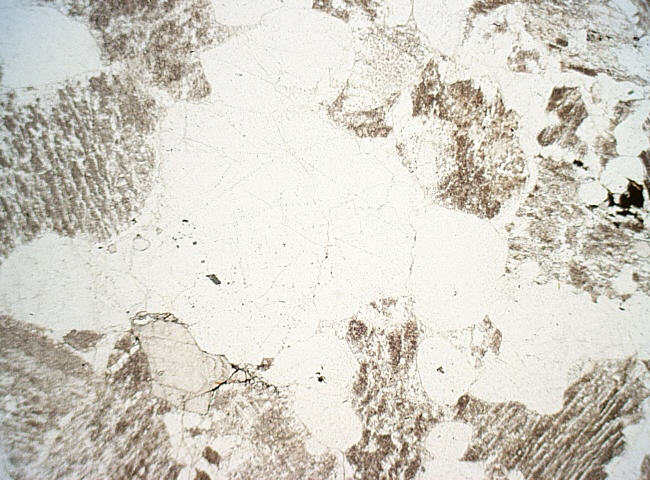 |
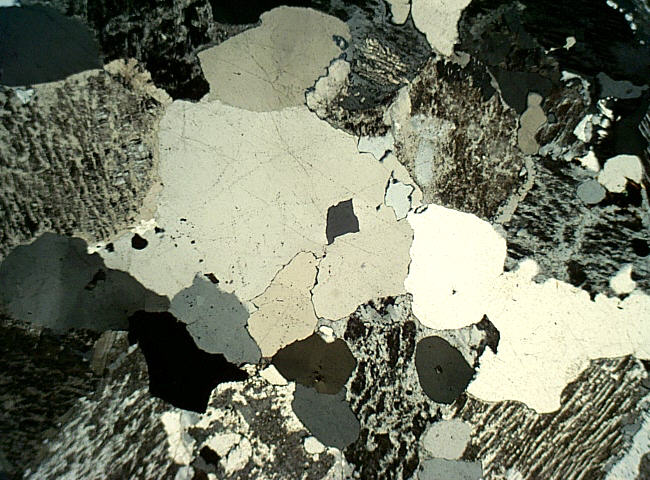 |
| Quartz crystals in alkali granite. Quartz is
typically the most transparent mineral in rocks, because it is not very
succeptible to alteration to fine-grained minerals, and it has no
cleavages. Birefringence in the low to middle first order. Plane/cross-polarized light, field width is 6 mm. NEIGC86-B2-7 |
アルカリ花崗岩中の石英.石英は典型的に岩石の中でもっとも透明な鉱物である.なぜならば,それは細粒の他の鉱物に変質しにくく,またへき開をもたないから.複屈折は程度から中度の1次 PPL/XPL,視野幅は6mm. |
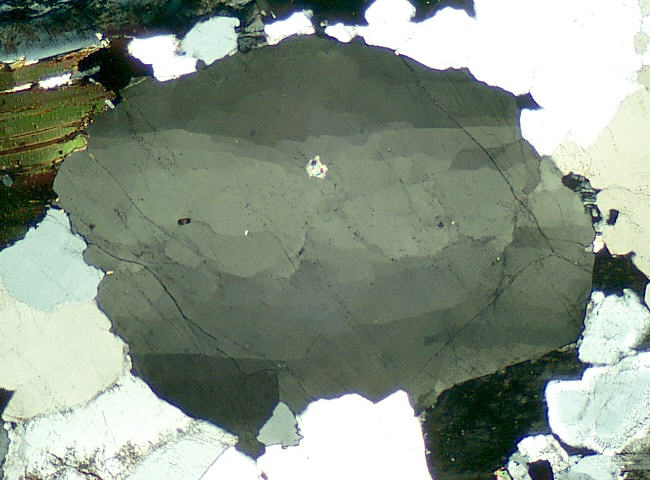 |
|
| Strained quartz crystal in a metaluminous granite.
Strain has caused the quartz crystal to deform into domains with
slightly different extinction angles. Typical for quartz, but not
feldspars. Cross-polarized light, field width is 6 mm. DIG-D |
金属質(酸化アルミニウムのモル比が少ない)の花崗岩中の歪んだ石英.歪みは,わずかに異なる消光の方向の領域を生じさせる.これは石英に典型的で長石には見られない. XPL,視野幅6mm. |
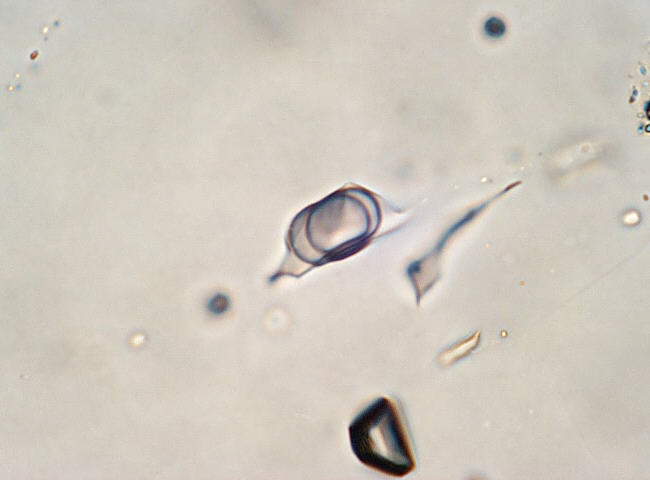 |
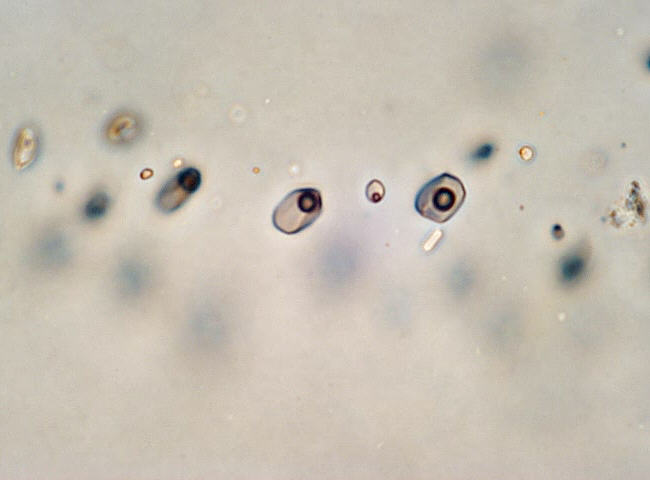 |
| Fluid inclusions in quartz in alkali granite. The
center inclusion has an irregular outer boundary, inside of which is a
layer of liquid water, a layer of liquid CO2, and a central bubble of vapor (mostly CO2). At the time the fluid was trapped, the fluid was a homogeneous H2O-CO2 fluid. Plane-polarized light, field width is 0.12 mm. NEIGC86-B2-7 |
アルカリ花崗岩中の石英の中の液体包有物.中央の包有物は不規則な外部境界を持ち,その中に水の層と液体CO2の層がある.そして中央の泡に泡があり,その多くはCO2である.液体がトラップされたときは,液体は水とCO2の均質な液体であった. PPL,視野幅は0.12mm. |
Plagioclase |
|
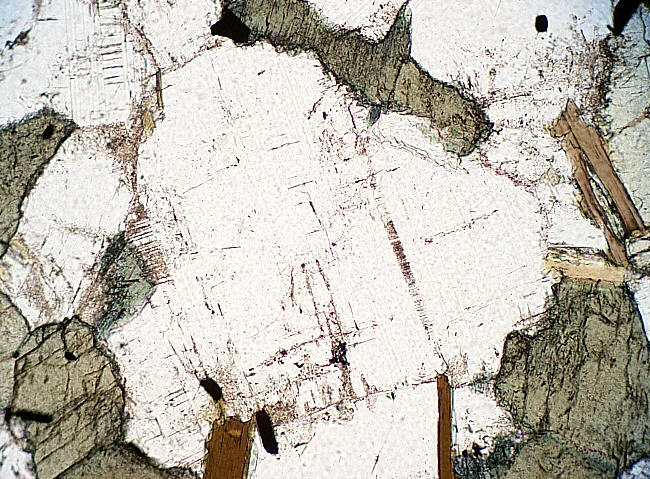 |
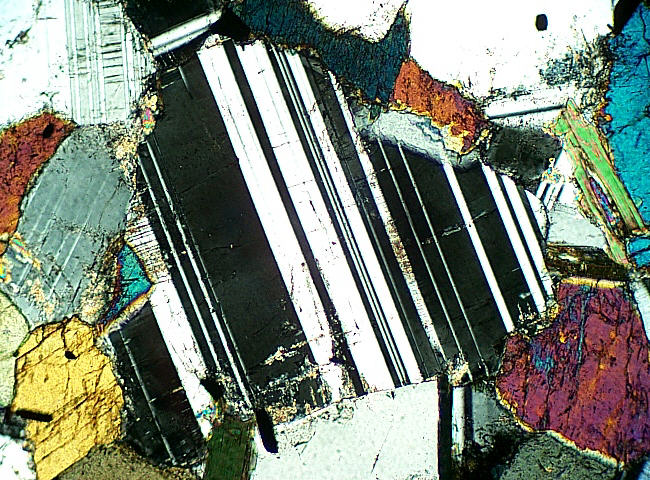 |
| Plagioclase, unzoned, in a hornblende diorite.
Alteration to fine-grained material typically occurs along fractures,
twin planes, or cleavages. In the solid solution series, the plagioclase
refractive index varies from slightly lower than quartz to somewhat
above it. Albite twins are prominent, and some small pericline twins can
also be seen. Plane/cross-polarized light, field width is 3 mm. NEIGC84-A5-5C |
普通角閃石閃緑岩中のゾーンされていない斜長石.双晶の境界やへき開,
割れ目に沿った,細粒物質への変質は普通に見られる.固溶体の系列で,斜長石の屈折率は石英よりわずかに低い場合からやや高い位置まで変化する.アルバイ
ト双晶が顕著である.そして小さなペリクリン双晶(訳註.消光角が大きい)も見える. PPL/XPL,視野幅は3mm. |
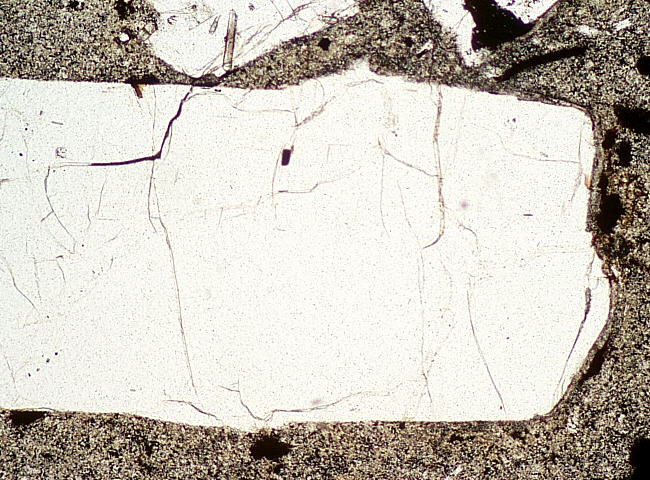 |
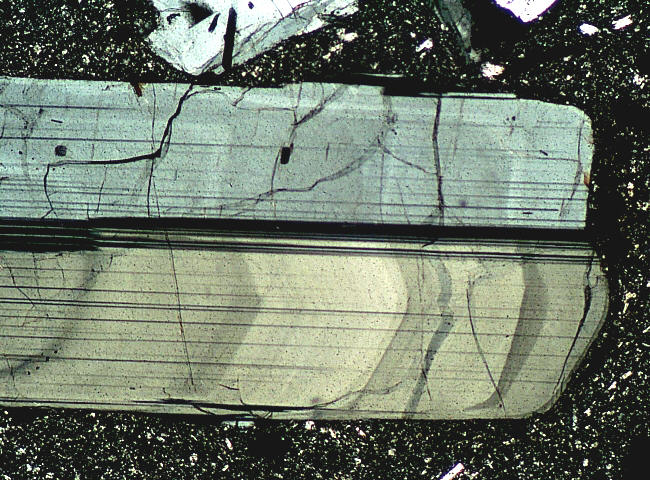 |
| Plagioclase, zoned, in a dacite porphyry. This grain
appears quite homogeneous in plane light, without concentric zones of
inclusions that are commonly seen elsewhere. In cross-polarized light
fine oscillatory zoning is visible, in which the composition varies back
and forth between more and less anorthite-rich compositions. Internal
unconformities followed by euhedral overgrowths are also visible. Plane/cross-polarized light, field width is 3 mm. Rhyolite-2 |
デーサイト斑岩の塁帯構造をもつ斜長石.この粒ではPPLでは至るところに見える包有物の集中したゾーン以外はきわめて均質.XPLでは周期的で明白な塁帯構造が見える.そこでは,成分はAn成分の多いか少ないかの違いに依存する.内部の自形成長による不整合も見える. PPL/XPL,視野幅は3mm. |
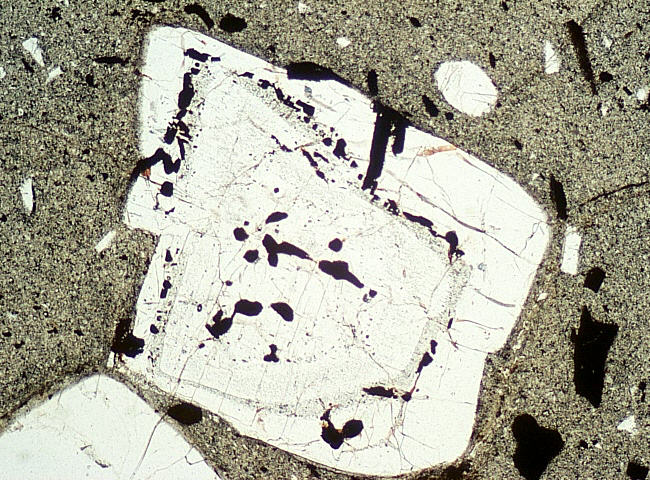 |
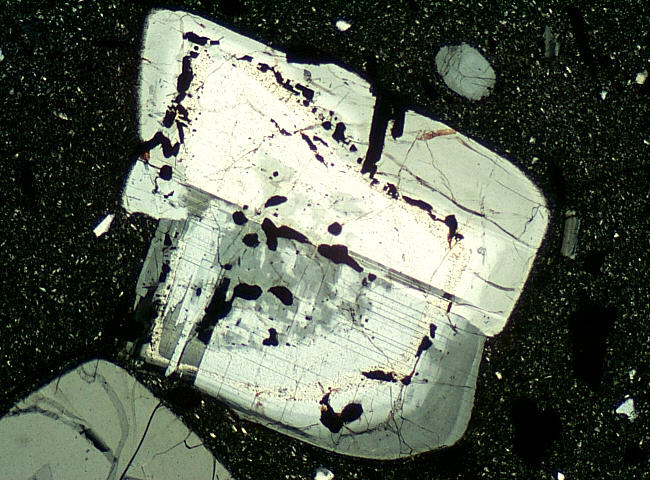 |
| Plagioclase, zoned, in a dacite porphyry. Notice the
concentric layers (zones) of inclusions. These probably formed during
faster crystal growth than the clear zones. In cross-polarized light you
can see that the zones also have different birefringence, indicating
they have different anorthite content. The interior of this crystal has
patchy zoning rather than concentric, indicating skeletal early growth.
Albite, carlsbad, and pericline twins cut across the zones. Plane/cross-polarized light, field width is 1.2 mm. Rhyolite-2 |
デーサイト斑岩中の塁帯構造をもつ斜長石.包有物の集積層(帯)に着
目.これらは均質な場所より速い結晶成長で作られたと考えられる.XPLでは塁帯は異なった複屈折を持つことも観察できる.それは異なるAn成分の反映で
ある.この結晶の内部では集積部に比べてパッチ状の塁帯を持つ.それは骨格を持った初期成長をしめしている.アルバイト,カルルスバッド,ペリクリン双晶
が塁帯を切っている. PPL/XPL,視野幅は1.2mm. |
| Potassium feldspars | |
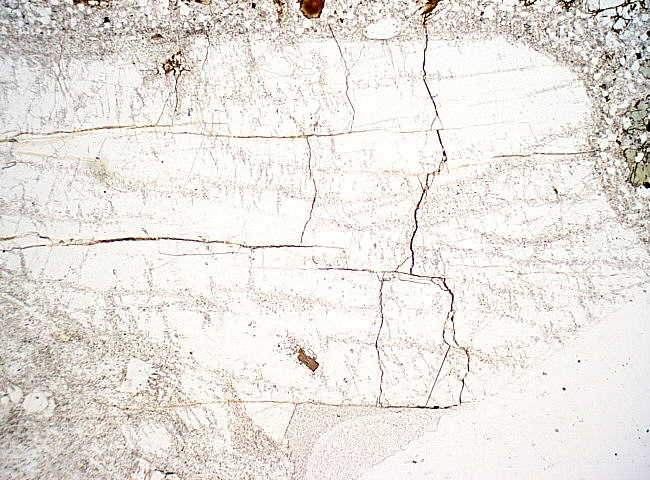 |
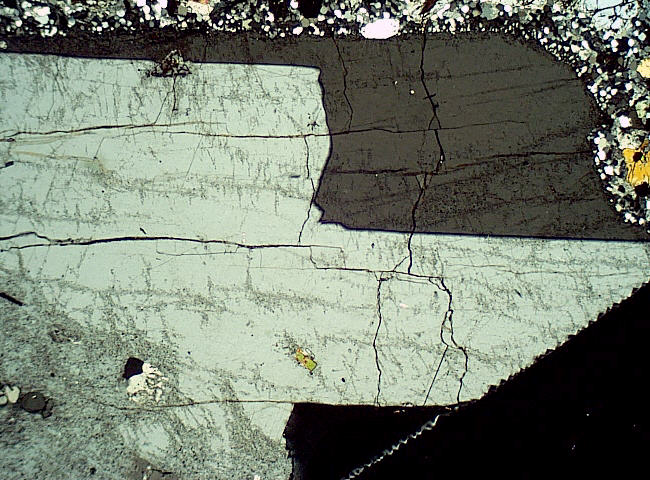 |
| Orthoclase in a dacite hypobyssal intrusive. In
plane-polarized light K-feldspars may be difficult to tell from
plagioclase, though plagioclase has higher refractive indexes. Hint: to
highlight K-feldspar, switch to a medium or low magnification objective
(usually 4 or 10X works well), mostly close the substage iris, and raise
the stage slightly (yes, raise). Though the image will be somewhat out
of focus, the low index K-feldspar grains will be surrounded by bright
Becke lines just inside the grain boundaries. This is especially handy
in tonalites, in which K-feldspar may be hard to find by other methods. Plane/cross-polarized light, field width is 3 mm. Py-28 |
デーサイトの半深成岩の貫入岩体中の正長石.PPLではカリ長石は斜長
石との違いをいうのは難しい.斜長石の方が高い屈折率をもつのだが.ヒントとして,中から低倍率に変換して(通常4から10倍が適当),サブステージの絞
りを閉じ,ステージを少しだけ上げる(ここ重要上げる!).そうすると,画像は少し焦点からずれる.そのとき低屈折率のカリ長石は,鉱物境界のちょうど内
側が,明るいベッケ線で囲まれているのが見える.これはカリ長石をほかの方法で見つけることが難しい,トーナライトにおいて特に有効. PPL/XPL,視野幅は3mm. |
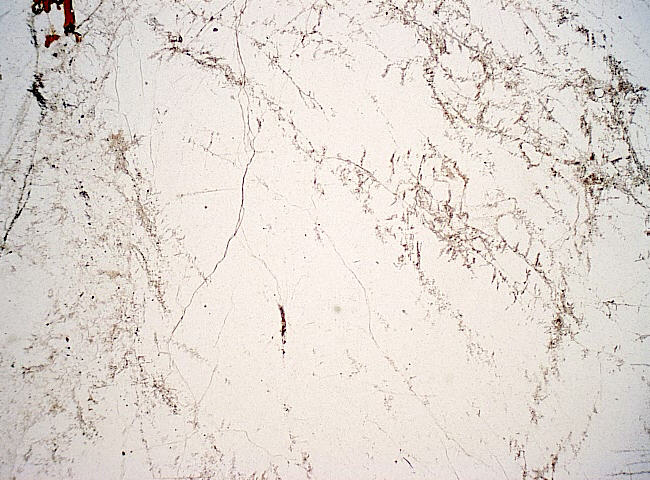 |
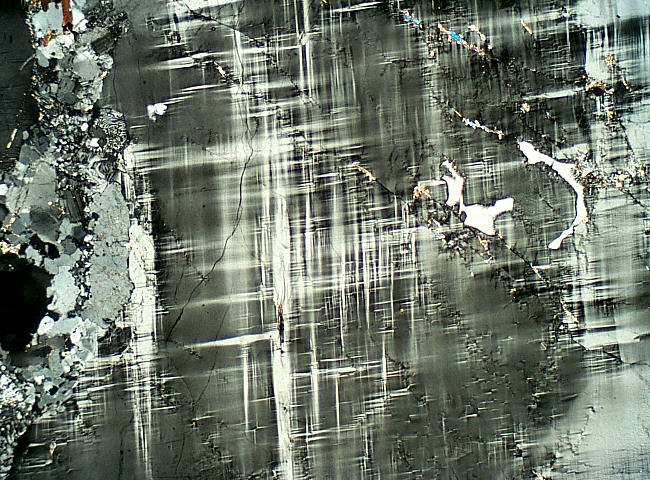 |
| Microcline from a peraluminous granite.
Characteristally featureless in plane light, but the inverse Becke line
highlighting technique described for orthoclase works just as well for
microcline. In cross-polarized light you can see the striking "grid" or
"tartan plaid" twinning pattern that results from crossing albite and
pericline twin domains. These form during cooling, as the grain changes
from monoclinic orthoclase to triclinic microcline. This transformation
is associated with progressive ordering of aluminum and silicon. Albite
and pericline twins are impossible in monoclinic orthoclase and
sanidine, and develop like this only during inversion to triclinic
microcline. The triclinic twin domains can nucleate with the triclinic
angles leaning one way or another in both the albite and pericline twin
directions. However, once they start, that is how the twin continues to
grow. Because many twin domains nucleate throughout the crystal, there
are large numbers of thin, spindly and discontinuous domains in the
final microcline product. Plane/cross-polarized light, field width is 6 mm. Kinsman |
酸化アルミナ成分の多い,花崗岩からの微斜長石.PPL
では特徴的な性質を持たない.しかし正長石で記述した逆ベッケ線光手法を微斜長石でも用いることができる.XPLでは格子状あるいはタータンチェックの双
晶パターンが衝撃的.それはアルバイトとペリクリン双晶の領域がクロスして生じる.これらは冷却途中で,単斜晶系の正長石が,三斜晶系の微斜長石に変わる
ことで生じる.この変化はアルミニウムと珪素の順序の進行と関係する.単斜晶系の正長石とサニディンでは,アルバイト双晶とペリクリン双晶は不可能であ
る.そしてこれは三斜晶系の微斜長石への変換においてのみ発達する.三斜晶系の双晶は アルバイトかペリクリンの双晶の方向の片方か両方の三斜角でのみ結晶核ができる.しかし,一旦それがスタートすると,双晶は連続的に成長を続ける.結晶中で多くの双晶の核が形成されるため,とても多い数の薄い尖った領域が最終的に微斜長石として作られる. PPL/XPL,視野幅は6mm. |
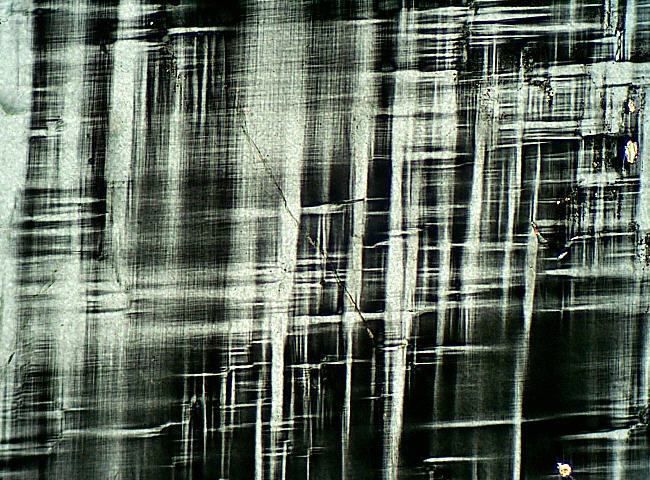 |
|
| Microcline from a peraluminous granite. Close-up of
the grid twinning. Notice how the twin domains are spindly and somewhat
wispy. This is in contrast to the straight, and generally continuous
twins in plagioclase. Note the variable spacing of the twin domains,
indicating that different volumes of the crystal nucleated different
numbers of twin domains during inversion. Cross-polarized light, field width is 1.2 mm. Kinsman |
酸化アルミナ成分の多い,花崗岩からの微斜長石.
格子双晶の部分のクローズアップ.いかの双晶の領域が尖って,ささくれ立っているのかがわかる.これは斜長石の一般的に直線的に連続した双晶とは対称的.
また双晶の間隔は変化している.それはこの形成過程において,最初の核ごとの異なる体積と,双晶領域の異なる数を示している. XPL,視野幅は1.2mm. |
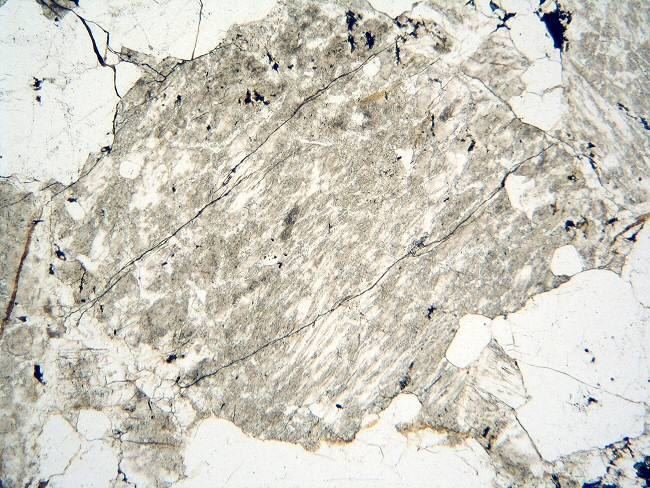 |
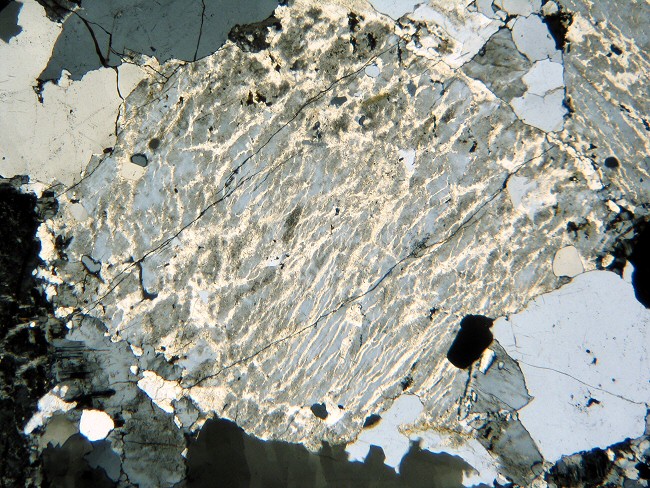 |
| Perthite from a metaluminous biotite granite.
Perthite is an unmixing texture of an originally homogeneous feldspar
grain. Microcline and albite both exsolved (unmixed) from the
homogeneous solid solution during cooling. Note the faint, irregular
stripes that run from the upper right to lower left. In this case, the
exsolved albite is less altered (clearer) than adjacent microcline,
which is grayish because of lots of minute alteration minerals. In
cross-polarized light you can see the lighter, irregular stripes and
patches of bright yellowish-white birefringence albite between gray
microcline. The birefringent color difference is mostly caused by the
different optical orientations of the two different minerals. In this
photo the thin section was rotated to obscure twinning. Plane//cross-polarized light, field width is 6 mm. 4.7.84H |
酸化アルミナ成分が低い黒雲母花崗岩中のパーサイト.
パーサイトは元々均質だった長石の不混和組織である.冷却の過程でアルバイト双晶と微斜長石が両方共離溶状態で(混ざり合わず)結晶した.弱い不規則な縞
が右上方から左下方に走る.このケースでは,離溶したアルバイト双晶は隣接する微斜長石より,変質が少ない.微斜長石は多くの変質した細粒鉱物のために灰
色を帯びている.XPLでは灰色の微斜長石の間の明るい黄白色の複屈折のアルバイト双晶の不規則な縞とパッチ状の組織が見える.複屈折の色の違いは異なる
鉱物の光学的方向の違いにより生じる.この写真では薄片は双晶の様子がわからない位置に回転している. PPL/XPL,視野幅は6mm. |
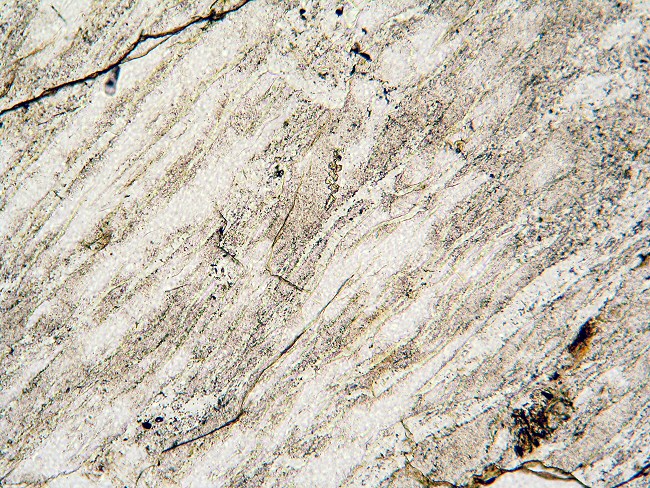 |
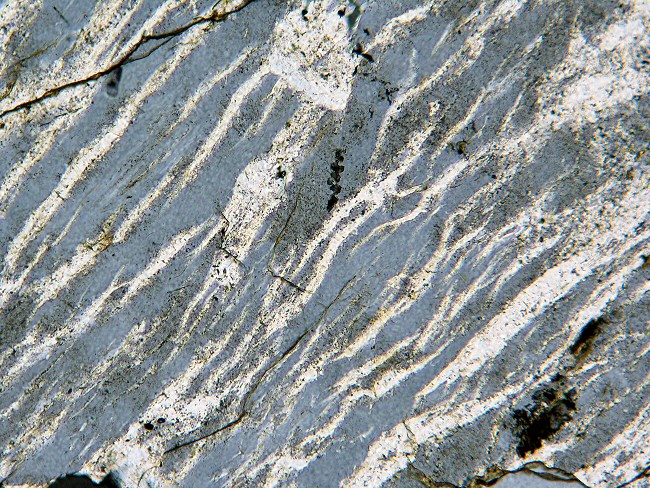 |
| Perthite from a metaluminous biotite granite. The
somewhat less-altered and narrower albite exsolution lamellae are in
sharp contact with larger microcline domains. A Becke line test tells
you which phase is which: the Becke line goes into the higher index
phase, albite. Plane/cross-polarized light, field width is 1.2 mm. 4.7.84H |
酸化アルミナ成分が低い黒雲母花崗岩中のパーサイト.いくらか変質の少なく狭いアルバイト離溶ラメラが大きな微斜長石の領域とシャープな接触を示している.ベッケ線の試験がどちらかを示してくれる:すなわちベッケ線は,高い屈折率のアルバイト相の方に動く. PPL/XPL,視野幅は1.2mm. |
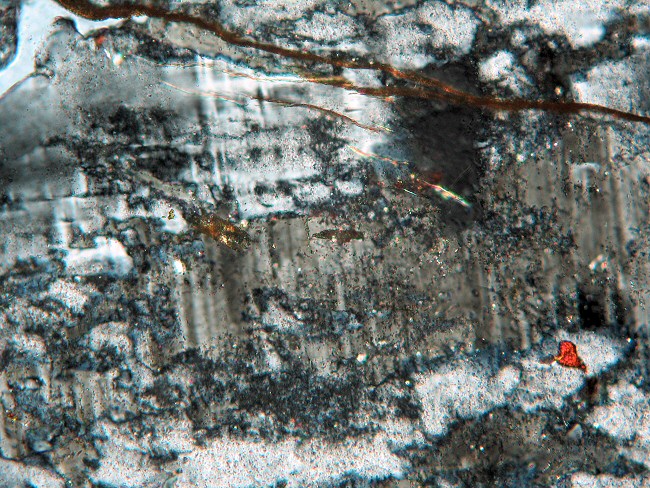 |
|
| Perthite from a metaluminous biotite granite.
Close-up showing the characteristic grid twinning in the microcline host
(upper center and upper left) and albite twinning in the lamellae
(lower center to center right). Cross-polarized light, field width is 0.6 mm. 4.7.84H |
酸化アルミナ成分が低い黒雲母花崗岩中のパーサイト.微斜長石中の特徴的な格子状の双晶をクローズアップしている. XPL,視野幅は0.6mm. |
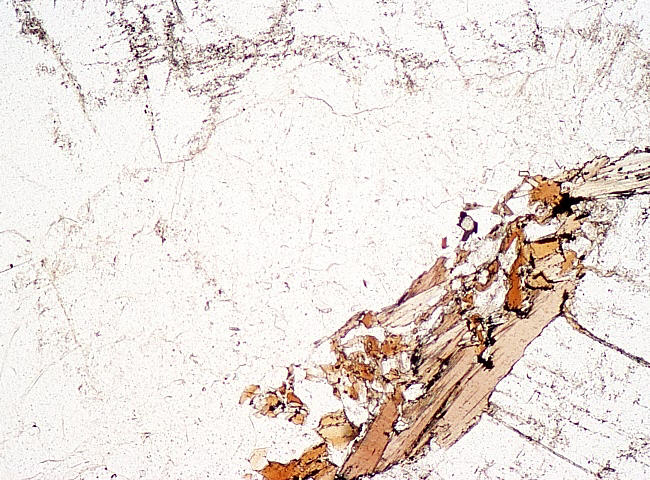 |
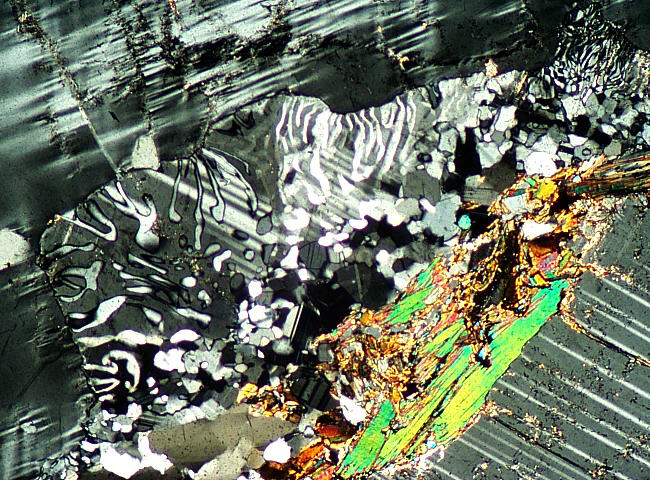 |
| Myrmekite patch that appears to be replacing
microcline. Though its presence is obscure in plane-polarized light, it
is obvious in cross-polarized light as quartz worms in plagioclase. The
plagioclase is twinned. Myrmekite is a subsolidus reaction texture that
generally results from fluid flow. Here, K-feldpar was removed and
quartz and plagioclase deposited in its place. Plane/cross-polarized light, field width is 3 mm. Kinsman |
微斜長石を置き換えるミルメカイトパッチ.これはPPLではよくわから
ないがXPLでは斜長石中の石英の虫食い状として明瞭である.斜長石は双晶している.ミルメカイトは一般的に液体の流れの結果できる準固相反応の組織.こ
こでは,カリ長石は移動され,その場所に石英と斜長石が沈殿している. PPL/XPL,視野幅は3mm. |
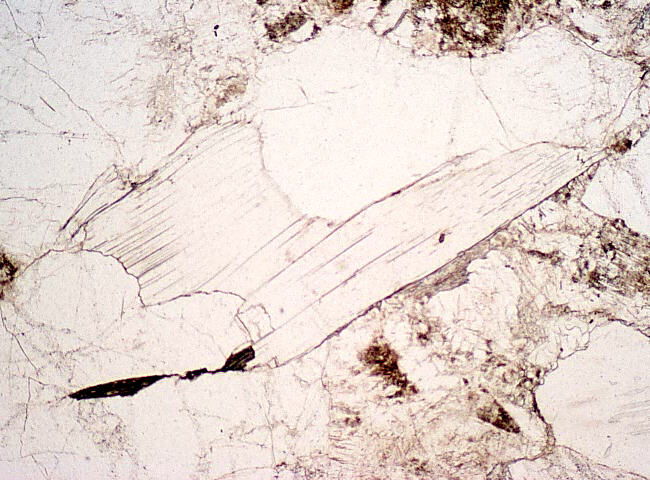 |
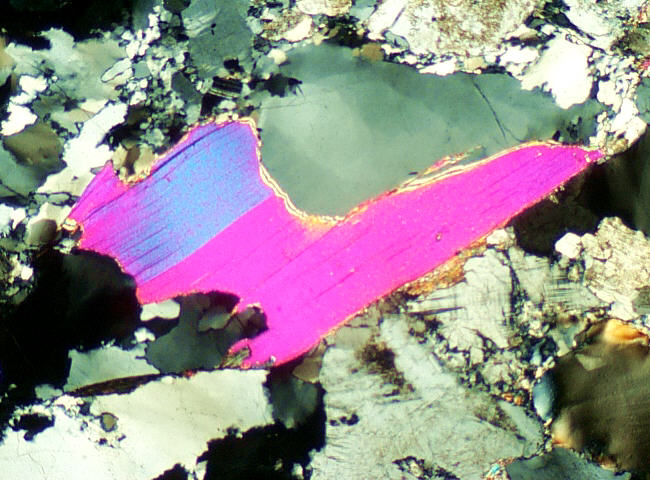 |
| Muscovite, peraluminous granite. Igneous muscovite
is generally colorless with good cleavage. Pale brown radiation halos
can sometimes be visible around radioactive inclusions (but not really
visible here). Birefringence is in the high first or second order. Plane/cross-polarized light, field width is 3 mm. NEIGC84-A5-6 |
酸化アルミナ成分の多い,花崗岩から白雲母.火成岩中の白雲母は一般的に無色でよいへき開を持つ.放射性包有物の周囲に淡い茶色の放射性ハローがみられる場合がある(ここではそれは見えないが).複屈折は高い1次あるいは2次. PPL/XPL,視野幅は3mm. |
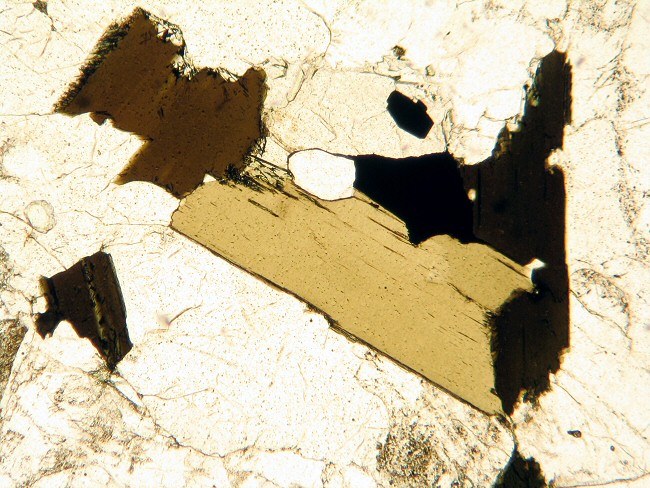 |
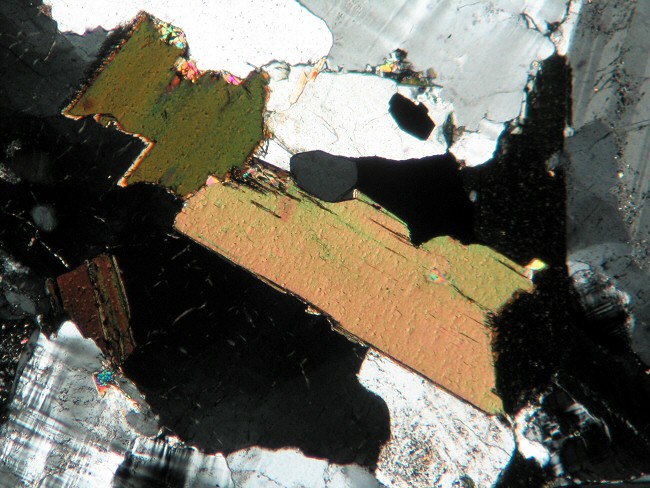 |
| Biotite, metaluminous granite, showing several
grains in different orientations. The grain on the far right is oriented
with cleavages N-S, and is almost opaque. The largest grain is inclined
and is lighter in color. Grains with the cleavages E-W have the least
absorption (not shown in this image). In cross-polarized light the
birefringent colors of the biotite are muted by the color of the biotite
itself. Plane/cross-polarized light, field width is 3 mm. 4.7.84G |
酸化アルミナ成分の少ない花崗岩中の黒雲母.幾つかの異なる方向の粒がみれる.1番大きい結晶は傾き,薄い色である.東西方向のへき開の粒(ここには見えないが)はもっとも吸光が少ない.XPLでは複屈折の干渉色は,黒雲母それ自身の色にミュートされている. PPL/XPL,視野幅は3mm. |
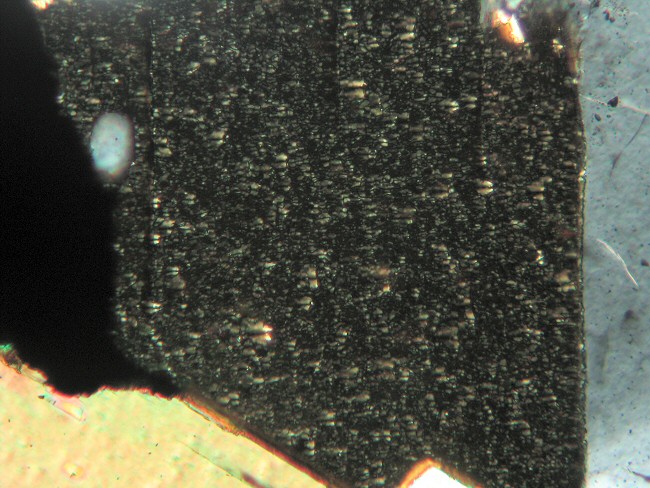 |
|
| Biotite, metaluminous granite, showing a close-up of
one crystal. Damage produced during thin section grinding causes
speckles of light in the biotite, where the crystal lattice has been
deformed. This means that biotite in standard thin sections rarely goes
completely extinct. This is called "incomplete extinction" or sometimes
"birds eye maple extinction". Cross-polarized light, field width is 6 mm. 4.7.84G |
酸化アルミナ成分の少ない花崗岩中の黒雲母.1つの結晶をクローズアップしている.薄片製作の過程で黒雲母の多数のスポット状のダメージ.そこでは結晶格子が変形している.これが黒雲母が標準の薄片では,完全な消光に至らない理由.これは不完全消光とか,鳥瞰もみじ消光とか呼ばれる. PPL/XPL,視野幅は6mm. |
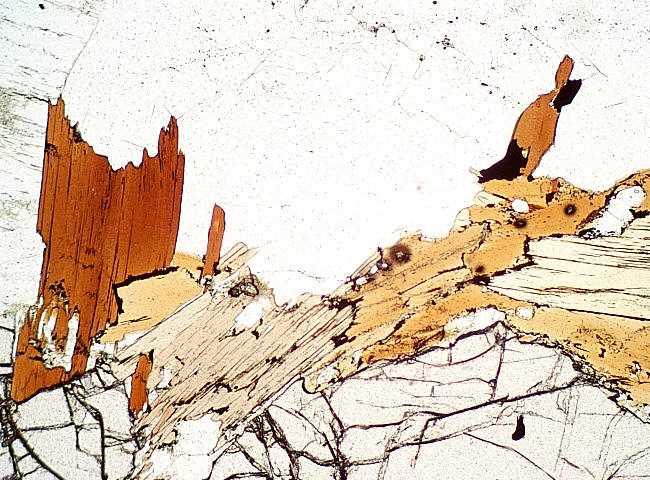 |
|
| Biotite, peraluminous granite. The red-brown biotite in this graphite- and garnet-bearing granite has high titanium and low Fe3+ content. This patch of biotite shows a range of pleochroic colors caused by different crystal orientations. Plane-polarized light, field width is 0.6 mm Kinsman |
酸化アルミナ成分の多い花崗岩の黒雲母.この石墨と柘榴石を含む花崗岩の赤茶色の黒雲母は,チタンに富み,Fe3+成分が低い.黒雲母のこのパッチは異なった結晶の向きにより生じた多色性の範囲を示す. PPL,視野幅は0.6mm. |
| Amphiboles | 角閃石 |
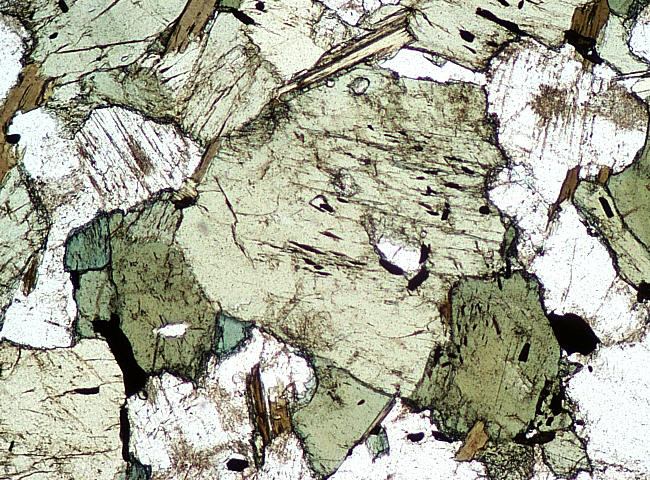 |
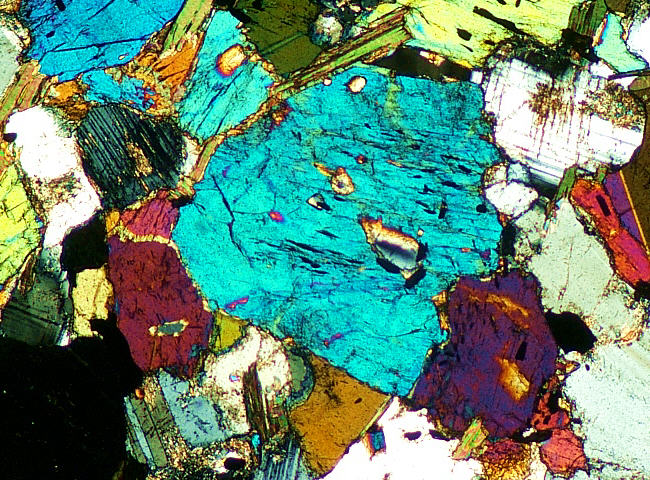 |
| Green hornblende in a diorite. Pleochroism in this
sample ranges from light-yellow-green to bluish-green to brownish-green.
Birefringent colors are typically up to middle second order. Plane/cross-polarized light, field width is 3 mm. NEIGC84-A5-5C |
閃緑岩の緑色普通輝石.このサンプルの多色性は明るい黄緑から青緑さらに茶色を帯びた緑と変化する.複屈折の色は典型的な中央2次に達するオーダー. PPL/XPL,視野幅は3mm. |
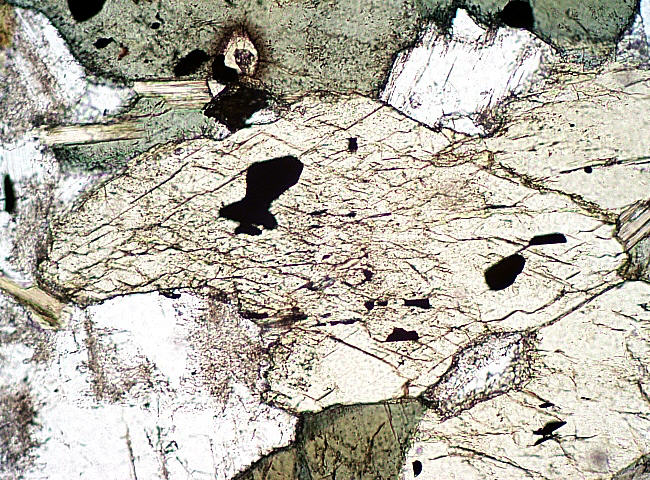 |
|
| Green hornblende in a diorite. The ~120° and ~60° cleavage intersections are clearly visible in this end section of a crystal. Plane-polarized light, field width is 1.2 mm. NEIGC84-A5-5C |
閃緑岩の緑色普通輝石.120°と60°のへき開の交差がこの結晶の端の断面で明瞭に見える. PPL,視野幅は1.2mm. |
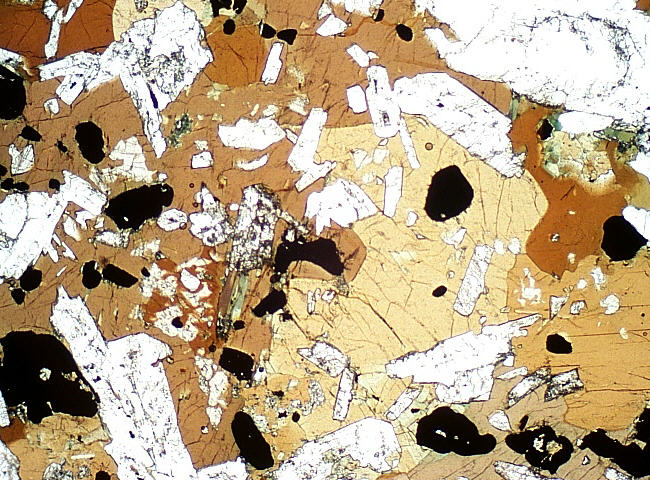 |
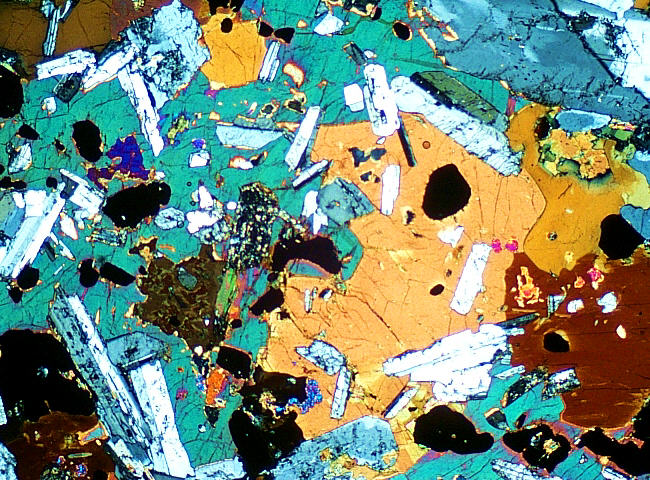 |
|
Brown hornblende in hornblende gabbro. The extensive
dark and light brown areas are different hornblende crystals in
different orientations. Note the numerous inclusions of opaques and
plagioclase.
Plane/cross-polarized light, field width is 6 mm. 4.8.84Q |
普通角閃石はんれい岩の茶色普通角閃石.消光に近い暗い色と明るい茶色の領域は異なる普通角閃石の結晶方向による.多くの不透明鉱物と斜長石の包有物を含んでいる. PPL/XPL,視野幅は6mm. |
| Pyroxenes | 輝石 |
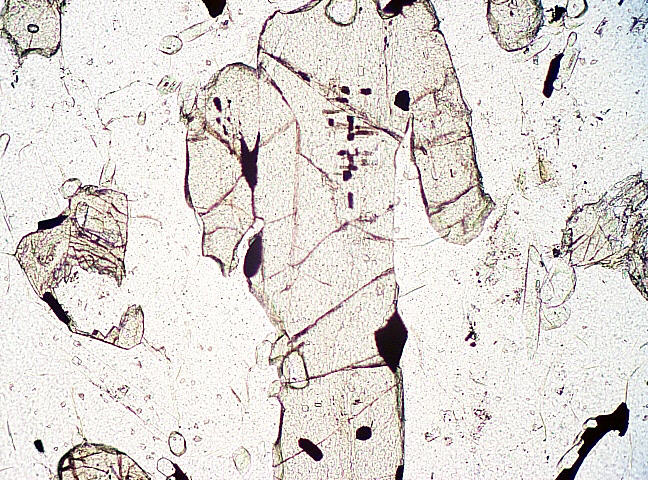 |
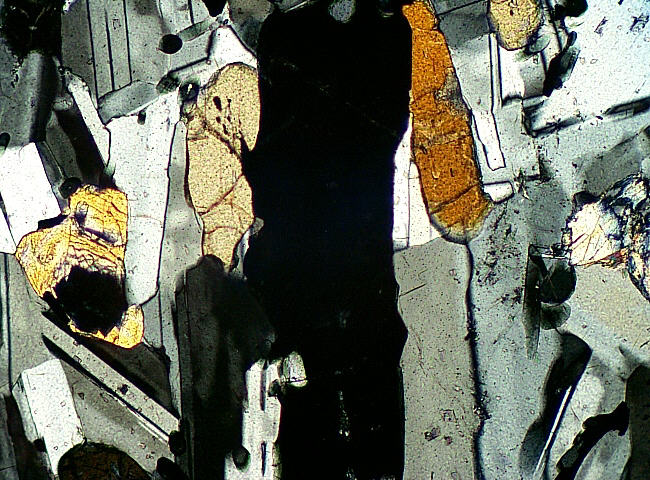 |
|
Enstatite (orthopyroxene, OPX) in norite. The large OPX in the center is oriented with its c crystallographic axis N-S. In cross-polarized light that crystal is at extinction, in keeping with the orthorhombic symmetry of this mineral. Birefringence ranges to middle first order. Plane/cross-polarized light, field width is 1.2 mm. NEIGC83-C1-14 |
ノーライト中の頑火輝石(斜方輝石,OPX).中央の大きなOPXはNS方向にC軸がある.XPLではこの結晶が,斜方晶系の対称性を持って直消光している.複屈折は1次の中間のあたりである. PPL/XPL,視野幅は1.2mm. |
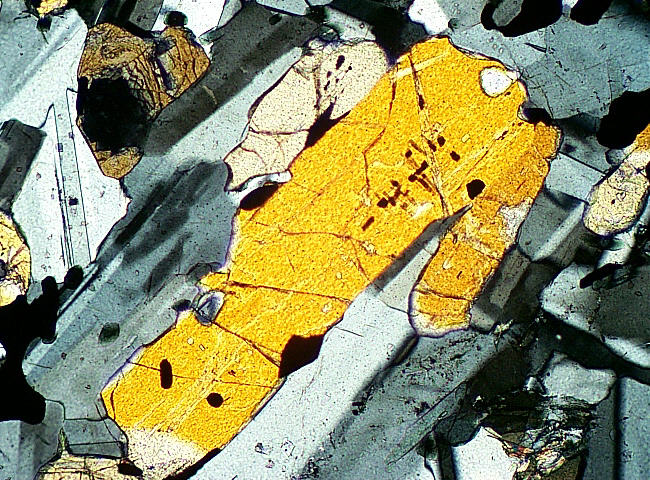 |
|
|
Enstatite (orthopyroxene, OPX) in norite. Here the thin section shown above has been rotated clockwise ~45° to show the birefringence of the large grain. Cross-polarized light, field width is 1.2 mm. NEIGC83-C1-14 |
ノーライト中の頑火輝石(斜方輝石,OPX).上に示すのは,45度時計周りに回転させた,大きな粒の複屈折. XPL,視野幅は1.2mm. |
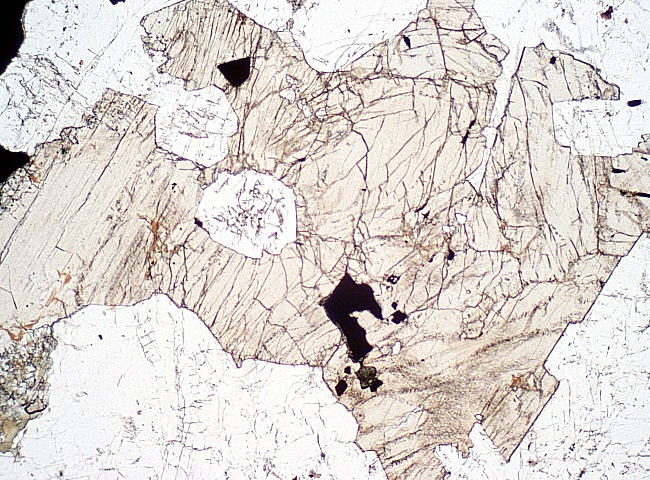 |
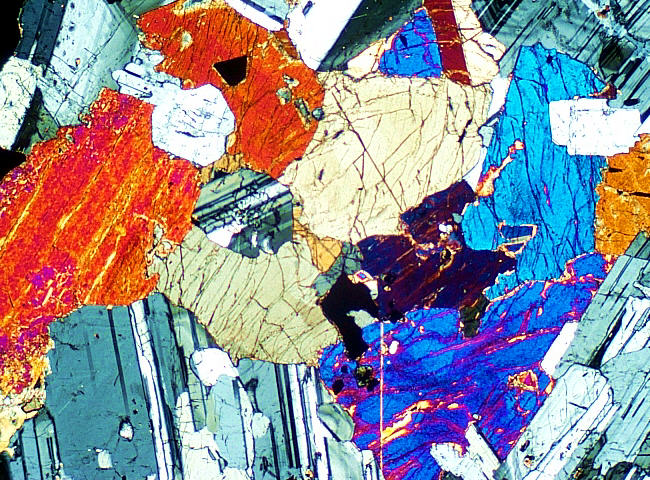 |
|
Augite (clinopyroxene, CPX), in gabbro. This augite is slightly brownish, and has tiny exsolved rods and plates of Fe-Ti oxide. These form the darkish, cloudy regions, especially in the grain to the lower right. Augite has birefringence up to second order blue. Birefringence tends to be somewhat irregular in single grains because of compositional variations. Plane/cross-polarized light, field width is 6 mm. 4.8.84A |
はんれい岩中の普通輝石(単斜輝石,CPX).この普通輝石はやや茶色みを帯びる.そしてFe-Ti酸化物の小さな離溶軸と板をもつ.それらは暗い曇った領域を持つ.特に下右の部分.普通輝石の複屈折は2次の青に達する.複屈折は1つの粒でも成分の変化により,やや不規則である. PPL/XPL,視野幅は6mm. |
Other rock-forming primary minerals |
|
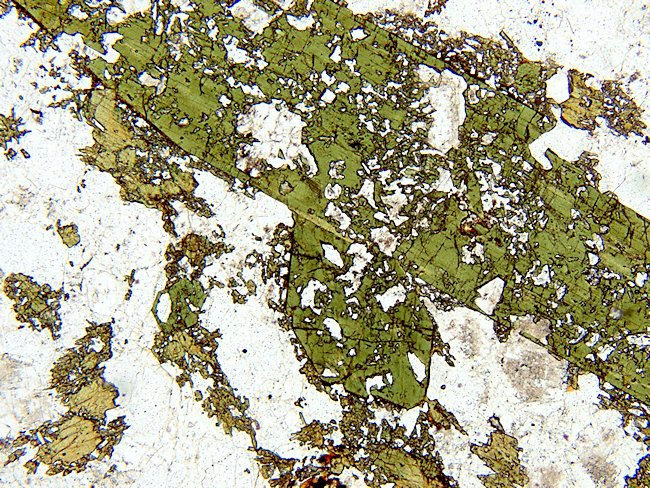
|
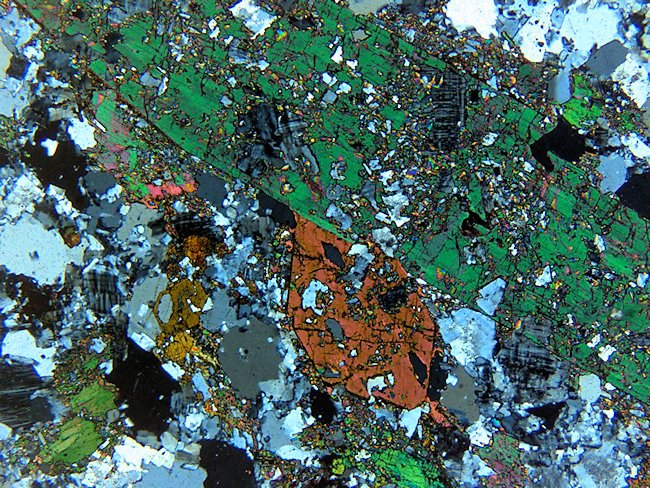 |
|
Aegirine (Na–Fe3+ monoclinic pyroxene), alkaline granite. These crystals have a lot of inclusions of quartz and feldspar. The pleochroic colors are similar to hornblende, but it has approximately right-angle cleavage intersections like the all pyroxenes. In cross-polarized light aegerine can be seen to have a smaller extinction angle than most hornblende, and negative elongation. Aegirine birefringence tends to be up to upper second to third order, higher than amphiboles and most other clinopyroxenes. Plane/cross-polarized light, field width is 3 mm. 4.8.84F |
アルカリ花崗岩のエジリン(Na–Fe3+単
斜輝石).この結晶は多くの石英や長石の包有物を持つ.多色性の色は角閃石に似るが,へき開はすべての輝石と同じ様に,直角に交差する.XPLではエジリ
ンは角閃石よりも小さな消光角を持つ.また伸長性が負である.エジリンの複屈折は高い2次から3次に達する.それは角閃石やほとんどの単斜輝石よりも高
い. PPL/XPL,視野幅は3mm. |
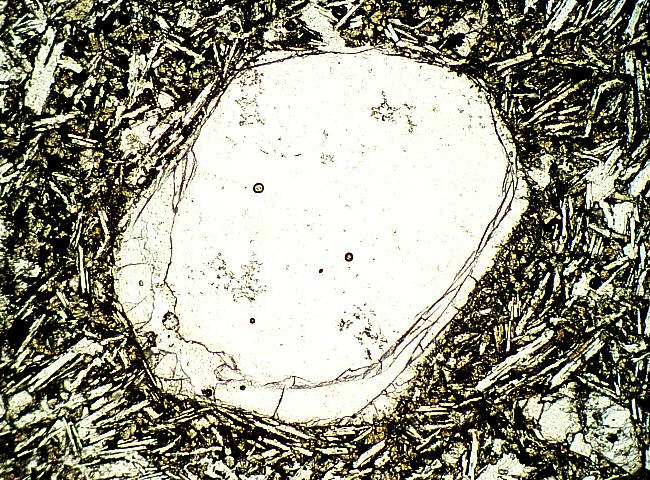 |
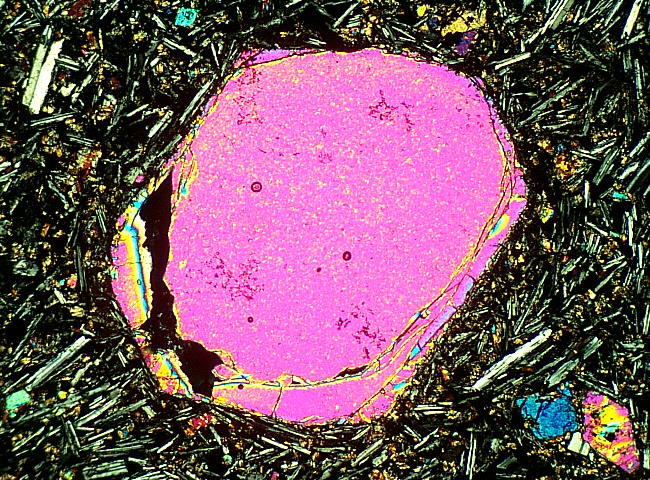 |
|
Olivine, phenocryst in an Iceland basalt. Notice the fractures concentric with the crystal margin. In cross-polarized light smaller "microphenocrysts" of brightly birefringent olivine and gray to white plagioclase can be seen. Augite occurs in the matrix as small, brownish crystals with brirefringence up to second order blue. Plane/cross-polarized light, field width is 3 mm. I-1 |
アイスランドの玄武岩の斑晶のかんらん石.結晶の縁で同心円状の割れ目がある.XPLでは,明るい複屈折のかんらん石の微小斑晶と,灰色から白い斜長石が見える.単斜輝石が基質の部分に茶色い結晶として見え,複屈折は2次の青に達する. PPL/XPL,視野幅は3mm. |
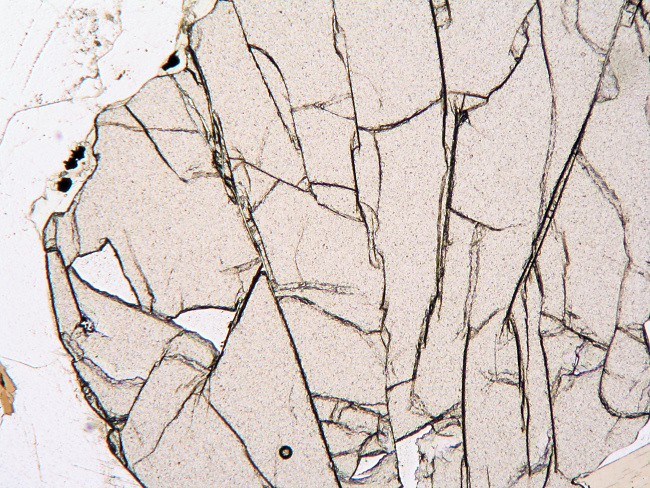 |
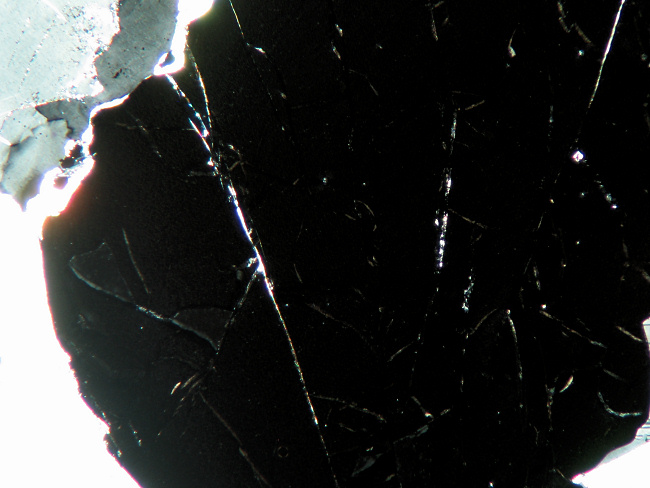 |
|
Garnet in a peraluminous granite. The high refractive index of garnet cause fractures and the grain margin to stand out as dark lines because of total internal reflection. The lack of birefringence distinguishes garnet from all other common high-index minerals. The bright cracks seen in cross-polarized light have thin films of calcite. Plane/cross-polarized light, field width is 3 mm. NHM-9 |
酸化アルミナ成分の多い花崗岩中のざくろ石.柘榴石の高い屈折率のため,割れ目や粒の縁は,内部の反射による,暗い線で縁取られる.他の高い屈折率の鉱物とは異なり,柘榴石は複屈折がないことで区別される.XPLでの内部の明るい亀裂は薄いカルサイトのフィルムである. PPL/XPL,視野幅は3mm. |
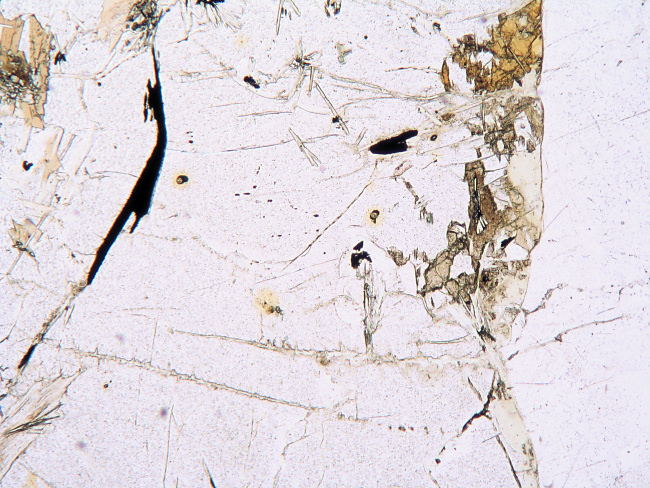 |
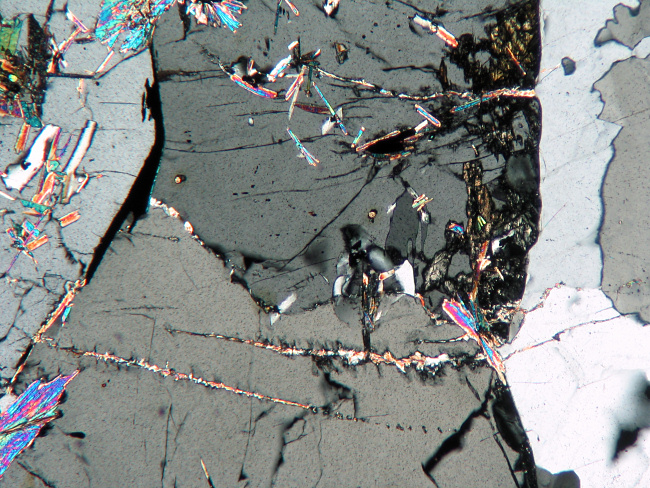 |
|
Cordierite in a peraluminous granite. In plane- and cross-polarized light cordierite looks much like quartz and feldspar, and it can be twinned or untwinned. It has three distinguishing characteristics. 1) It tends to look dustier than quartz and feldspar, little black specks all over the surface, such as can be seen here. 2) It commonly alters to brownish or orange material (top right), or to an intergrowth of Mg-rich chlorite and muscovite (most of the right margin to lower left). 3) Radiation halos are yellow and pleochroic, unless the it is very Mg-rich. Interference colors are first order gray to white, like quartz and feldspar. It is more commonly euhedral than quartz in plutonic rocks. The muscovite alteration products are easily visible here, but the Mg-rich chlorite is not so visible because of its low birefringence. Plane/cross-polarized light, field width is 3 mm. NHM-9 |
酸化アルミナ成分の多い花崗岩中の菫青石.PPL/XPL
で菫青石は石英や長石にそっくりに見える.そしてそれは双晶することもないこともある.ここに3つの見極めるべき特徴がある.1)石英や長石よりも,汚れ
て見える.2)通常茶色やオレンジ色に変質(上左)するか,Mgに富んだ緑泥石と白雲母の交差成長(右の大部分や下左)が見られる.3)Mgに富むにもか
かわらず,放射性ハローは黄色から多色性を帯びる.干渉色は石英や長石のように1次の灰色か白.深成岩では石英よりも自形を呈することが普通.白雲母の変
質生成物がここでは容易に見られる.しかしMgに富む緑泥石はその低い複屈折のために,それほど簡単に見られない. PPL/XPL,視野幅は3mm. |
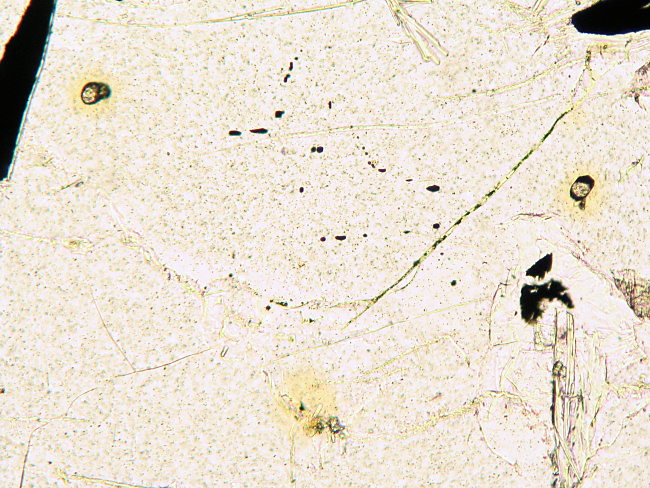 |
|
|
Cordierite in a peraluminous granite. This shows three radioactive inclusions with their yellow radiation halos, caused by alpha particle radiation damage. Plane-polarized light, field width is 1.2 mm. NHM-9 |
酸化アルミナ成分の多い花崗岩中の菫青石.この薄片には黄色の放射ハローを持つ3つの放射性包有物が含まれる.これらはアルファ崩壊によりダメージである. PPL,視野幅は1.2mm. |
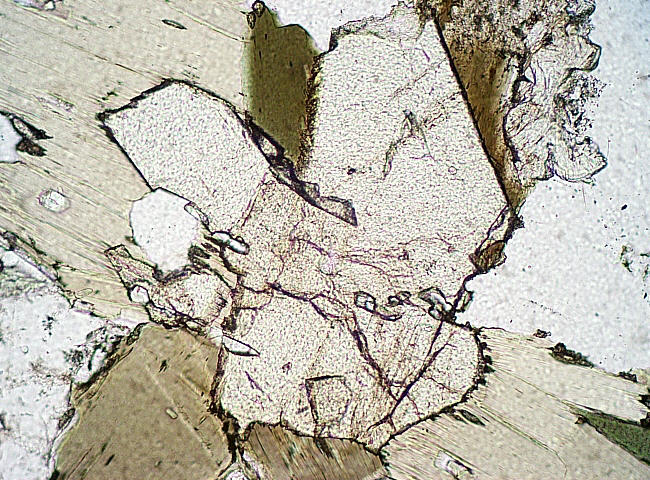 |
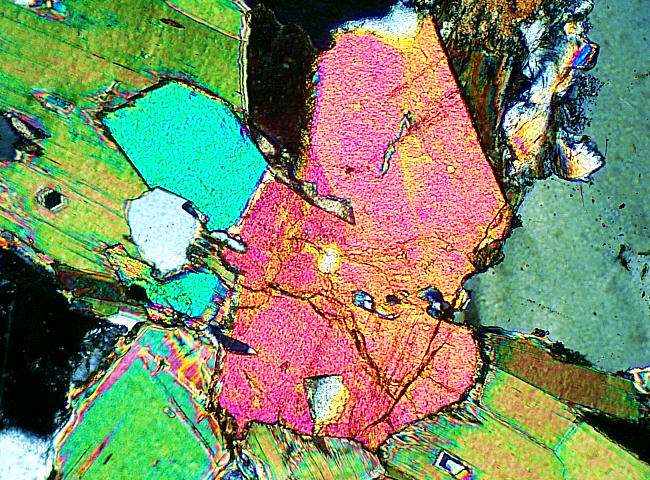 |
|
Epidote in a calc-alkaline granodiorite. In general, epidote in igneous rocks has rather high Fe3+ content, which may color it pale yellow-green. Birefringence and color may define zoning, and both increase with Fe3+ content. The birefringence is usually 2nd and 3rd order and so epidote, with its high relief and common lack of color, can resemble olivine. It is commonly associated with other Ca-rich minerals like hornblende, plagioclase, and titanite. Epidote may have simple twinning, and can occur with quartz and various hydrous minerals like chlorite and sericite. Olivine is usually not associated with quartz (except in highly Fe-rich Mg-poor rocks), and is likely to be partly altered. Plane/cross-polarized light, field width is 1.2 mm. UN30A |
カルクアルカリ花崗閃緑岩の緑簾石.一般的に火成岩中の緑簾石は高いFe3+成分を持つ.そのため色は淡い黄緑色になる.複屈折と色はゾーニングで変化する.Fe3+成
分が増えると両方とも上がる.複屈折は通常2次から3次で,その高い屈折率と通常無色の状態はかんらん石に似る.それは通常他のCaに富む鉱物,角閃石や
斜長石,それにチタン石などを伴う.緑簾石は単純な双晶を持つこともあり,他の含水鉱物の緑泥石やセリサイトなどと共存する.かんらん石は通常,石英と共存しない(鉄に高く富みMgに乏しい場合を除く),そして部分的に変質していることが多い. PPL/XPL,視野幅は1.2mm. |
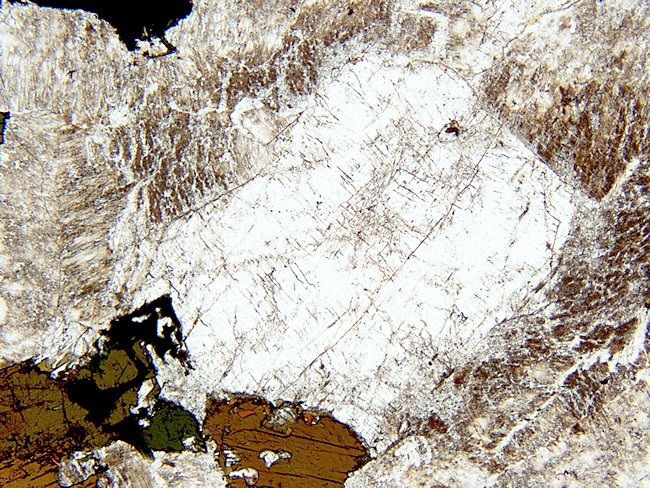 |
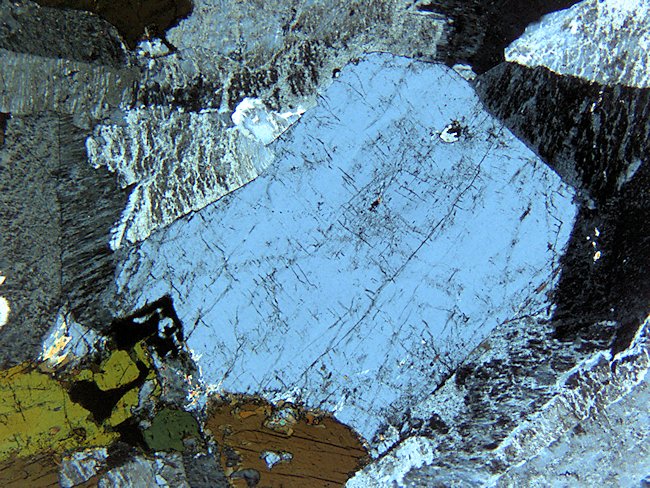 |
|
Nepheline in a nepheline syenite. It is distinguished from alkali feldspar by lack of perthitic intergrowths, from plagioclase by lack of polysynthetic twinning, from both by parallel extinction on cleavage and uniaxial negative interference figure, from apatite by its much lower relief, and from quartz by its cleavage, common alteration, and uniaxial negative interference figure. Its birefringence is also somewhat lower than feldspars and quartz. Plane/cross-polarized light, field width is 3 mm. RH-1 |
霞石閃長岩の霞石.
これは,アルカリ長石とはパーサイトが含まれないことで,また斜長石とは多様な双晶がないことで区別できる.また直消光であること,1軸の負の干渉図,さ
らにアパタイトとはより低い屈折率,石英とはそのへき開,さらに変質が一般的で1軸の負の干渉図で区別できる.また複屈折は石英や長石などよりもいくらか
低い. PPL/XPL,視野幅は3mm. |
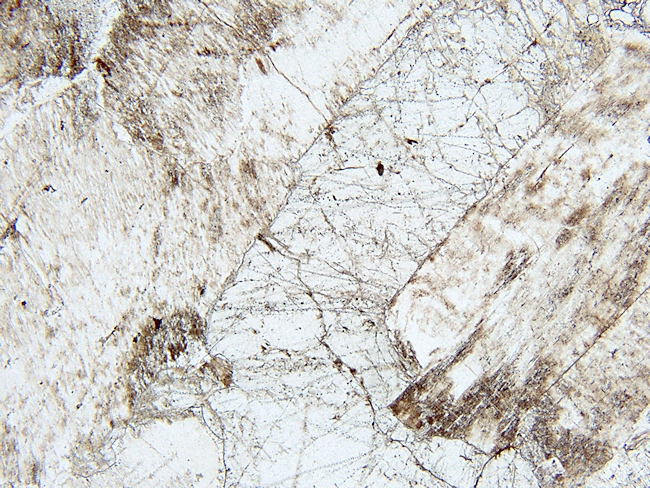 |
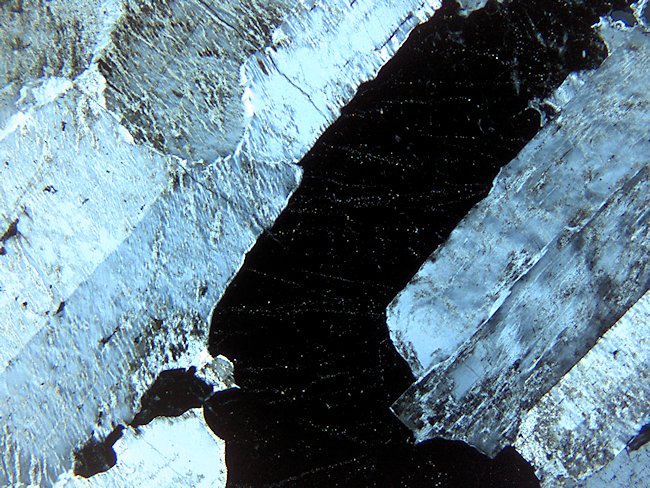 |
|
Sodalite in a nepheline syenite. This isotropic mineral has much lower relief than both garnet and fluorite, and its refractive index is closer to alkali feldspars and epoxy than either. In this view, healed fractures are highlighted by minute birefringent grains. Plane/cross-polarized light, field width is 3 mm. RH-1 |
霞石閃長岩のソーダ石.この等軸晶系の鉱物は柘榴石や蛍石よりもかなり低い浮き上がりを示す.そしてその屈折率はアルカリ長石やエポキシのそれに近い.この画面では,治療された亀裂が小さな複屈折の粒により浮かび上がっている. PPL/XPL,視野幅は3mm. |
Accessory minerals |
|
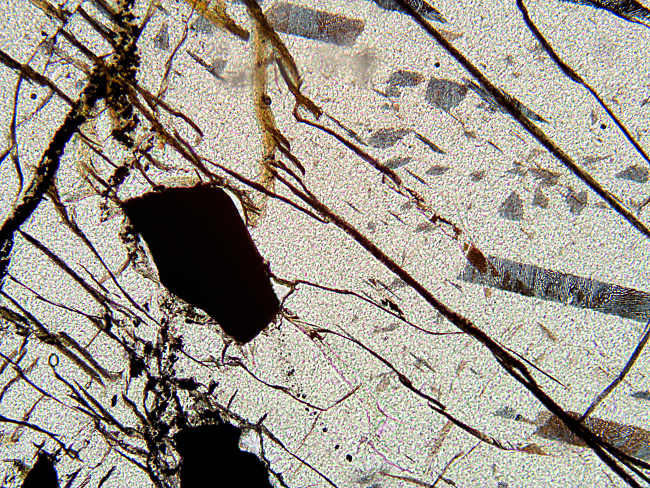 |
 |
|
Opaques inside olivine in an olivine gabbro. The large crystals are titanomagnetite, which crystallized from the relatively evolved gabbroic magma. There are also peculiar paralellogram- and trapezoid-shaped patches of wormy opaque material in the olivine. These are magnetite that formed during subsolidus oxidation of iron in the olivine. Oxidation turned some Fe2+ to Fe3+, precipitating magnetite by the reaction: olivine + O2 = magnetite + enstatite. Though it may seem obvious, opaque minerals are opaque in plane- and cross-polarized light, which differentiates them from isotropic, transparent minerals. Common opaque minerals include the oxides magnetite and ilmenite, sulfides pyrite, pyrrhotite, and chalcopyrite, and graphite. There are many others, but they are much less common. Yellow sulfides can be distinguished from gray oxides by using oblique illumination from above the section, with the substage light off. The sulfide and oxide colors become visible from light reflecting off the rough mineral surfaces. Plane/cross-polarized light, field width is 1.2 mm. 4.8.84D |
かんらん石はんれい岩のかんらん石中の不透明鉱物.大きな結晶はチタン磁鉄鉱.
これは比較的進化したはんれい岩マグマから結晶した.そしてまたかんらん石のなかに,多くの台形や平行四辺形の不透明なパッチが含まれる.それらはかんら
ん石の鉄の酸化に伴う固化の過程で生じた.Fe2+ から Fe3+への酸化により次の反応で磁鉄鉱が結晶する: かんらん石 + O2 = 磁鉄鉱 + 頑火輝石.これは明白であるが,不透明鉱物はPPL/XPLで不透明で,その点で透明な当軸晶系の鉱物とは区別できる. 普通の不透明鉱物は磁鉄鉱酸化物とチタン鉄鉱,黄鉄鉱,磁硫鉄鉱,黄銅鉱,そして石墨である.他にもたくさんあるが,通常は稀である. 黄色の硫化鉱物は灰色の酸化物とは,下部照明を消して,上方斜めからの照明で区別できる.硫化物と酸化物の色は粗い鉱物表面の光の反射を消すことで見えるようになる. PPL/XPL,視野幅は1.2mm. |
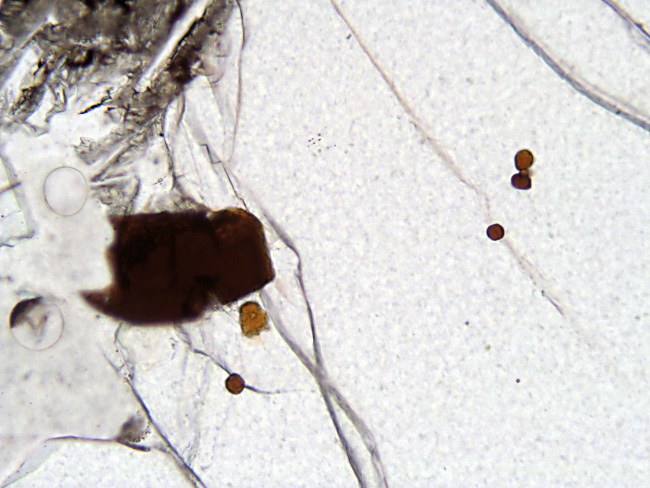 |
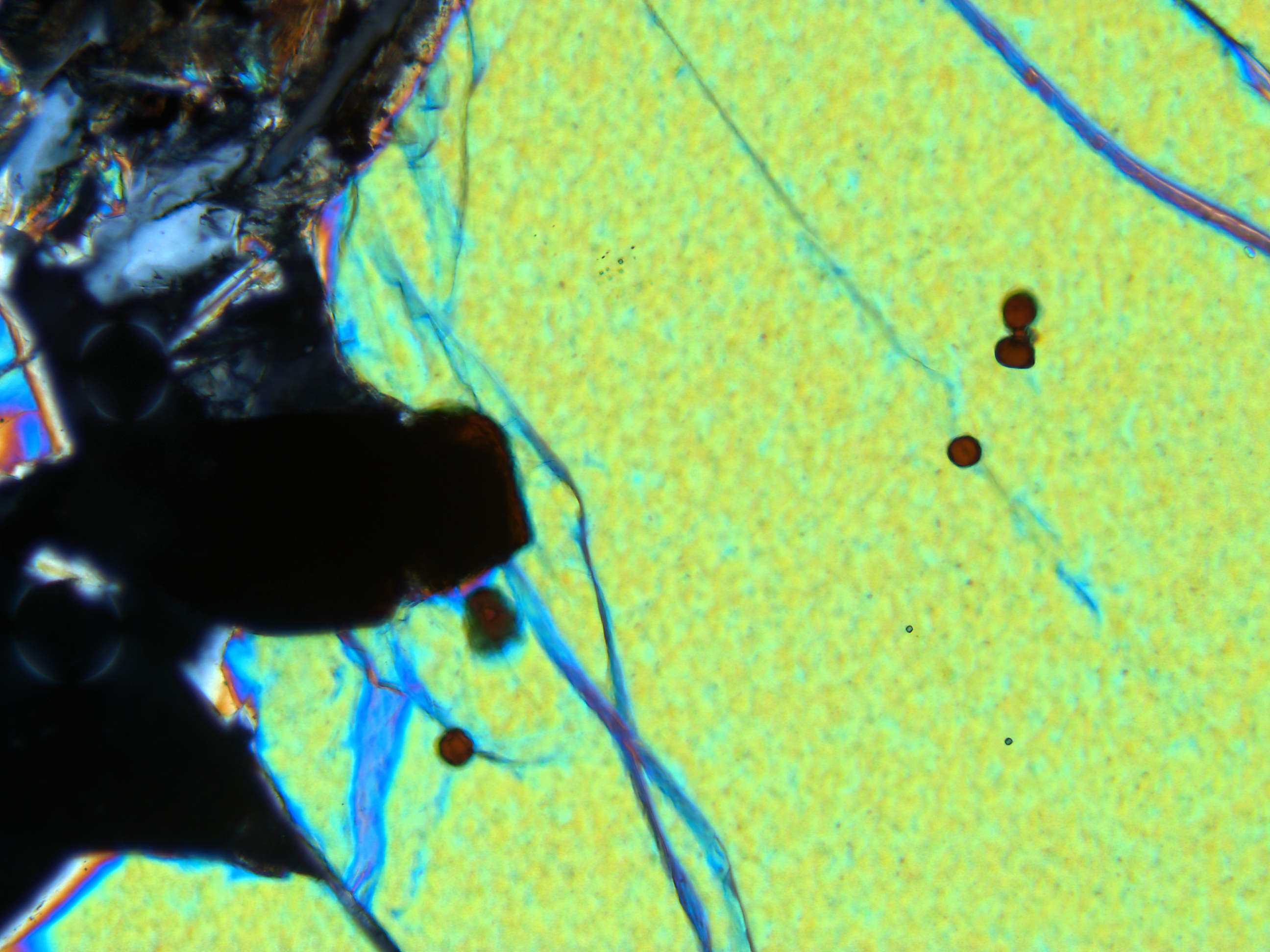 |
|
Chromite crystals in olivine in a primitive basalt. Chromite is dark-brown to opaque at full thin section thickness. Chromite is a spinel-type mineral, like magnetite, and has an extensive solid solution in the magnetite composition direction. Cr-Mg-Al-rich chromites are realtively transparent, and can be dark-brown at full thin section thickness. As the magma evolves toward more Fe-rich compositions, the chromite also becomes more Fe-rich and less transparent. Fe-rich chromite is typically opaque at full thin section thickness, but is transparent dark-brown along thin edges. The chromite shown here is relatively Fe-poor. Chromite is isotropic, like all spinels, with a very high refractive index. Plane/cross-polarized light, field width is 0.6 mm. ICE-24B |
原始的な玄武岩の中のかんらん石中のクロム鉄鉱.クロム鉄鉱(クロマイト)は薄片の厚さでは,濃茶色から不透明である.クロマイトは磁鉄鉱のようにスピネルタイプの鉱物で,磁鉄鉱成分方向に固溶体を形成する.Cr-
Mg-Alに富むクロマイトは実質的に透明であり,薄片の厚さでも濃茶色である.マグマがより鉄分に富む方向に分化すると,クロマイトもより鉄に富みさら
に不透明になっていく.鉄に富むクロマイトは典型的には薄片の厚さで不透明であるが,その縁に至ると濃茶色に透けて見える.この画像のクロマイトは相対的
に鉄に乏しいもの.クロマイトはすべてのスピネルと同じ等軸晶系で,大変高い屈折率を持つ. PPL/XPL,視野幅は0.6mm. |
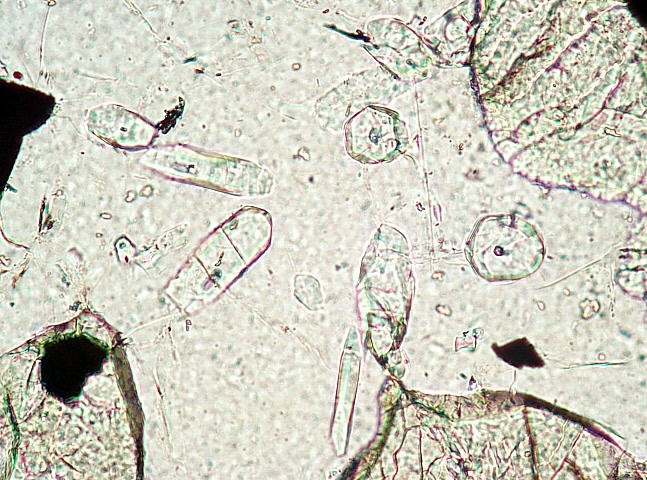 |
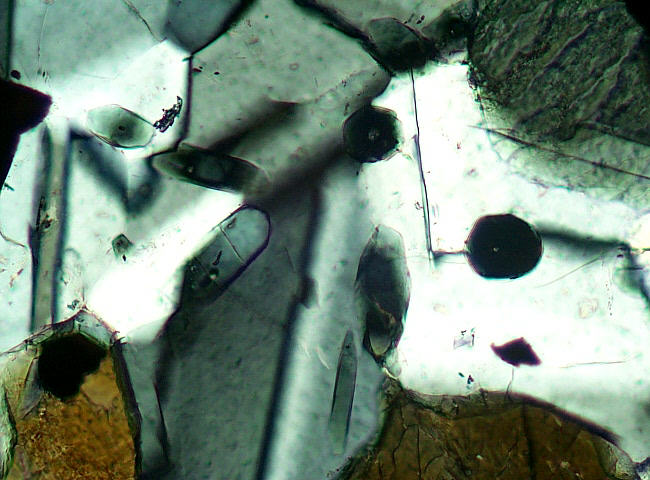 |
|
Apatite crystals in norite. This view has several apatite crystals mostly arranged in plagioclase, with surrounding OPX. Apatite is colorless, commonly elongate, and typically has hexagonal end sections. Its relief is less than the pyroxenes but higher than any feldspar. The very low 1st order birefringence is obvious, and it has negative sign of elongation. Apatite is extremely common in small amounts in igneous rocks. Indeed, it is rare to find a terrestrial plutonic rock without at least some apatite. Plane/cross-polarized light, field width is 1.2 mm. NEIGC83-C1-14 |
ノーライト中のアパタイト(燐灰石).
斜方輝石に囲まれた斜長石中に並んだ幾つかのアパタイトの結晶が見られる.アパタイトは無色で,ふつう長細く,典型的には端で六角形をしている.そのレ
リーフは輝石よりは低いが斜長石よりは高い.とても低い1次の複屈折が明らか.また負の伸長性を持つ.アパタイトは火成岩中で大変普通に小量存在する.実
際,アパタイトを含まない地球上の深成岩を探すことはとてもむずかしいほどである. PPL/XPL,視野幅は1.2mm. |
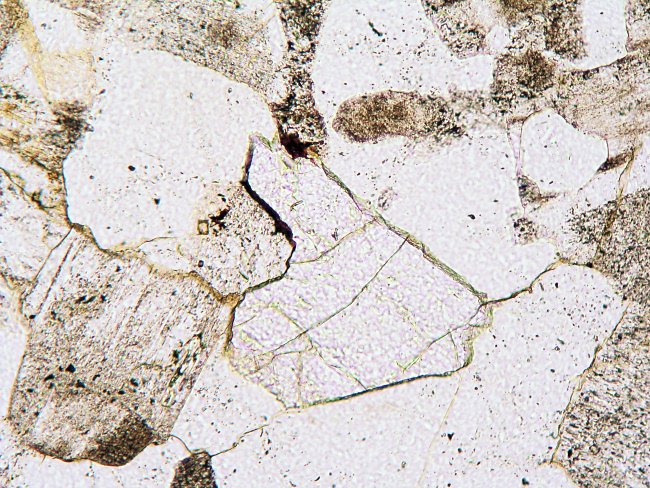 |
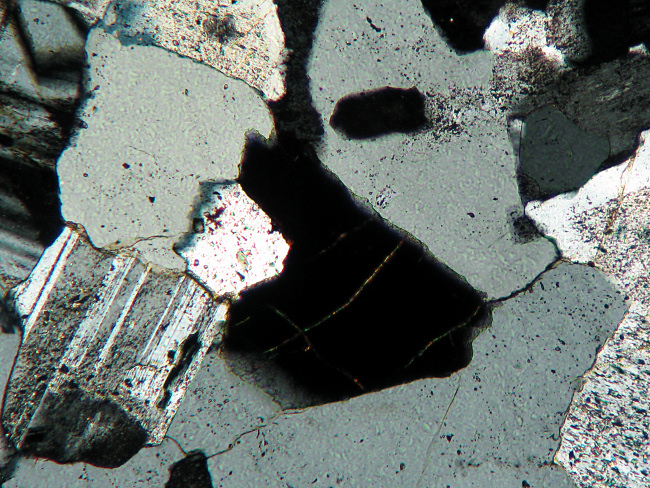 |
|
Fluorite in a metaluminous granite. The fluorite here is primary, as it occurs as euhedral and subhedral single crystals in a relatively fine-grained matrix. It has high negative relief, its refractive index being considerably lower than adjacent quartz and feldspar, and epoxy. Sodalite has much less pronounced relief and poorer cleavage. Fluorite, of course, is isotropic. Plane/cross-polarized light, field width is 1.2 mm. NEIGC86-B2-3B |
酸化アルミが少ない花崗岩中の蛍石.
ここでの蛍石は最初に生じたもの(訳註.他のものから変化ではない)で,相対的に細粒の基質の中に自形から半自形をする.大変高い負のレリーフを持ち,そ
の屈折率は周りの石英や長石そしてエポキシよりもかなり低い.ソーダ石はこれよりさらに低いレリーフと少ないへき開で区別できる.蛍石はもちろん等軸晶系
である. PPL/XPL,視野幅は1.2mm. |
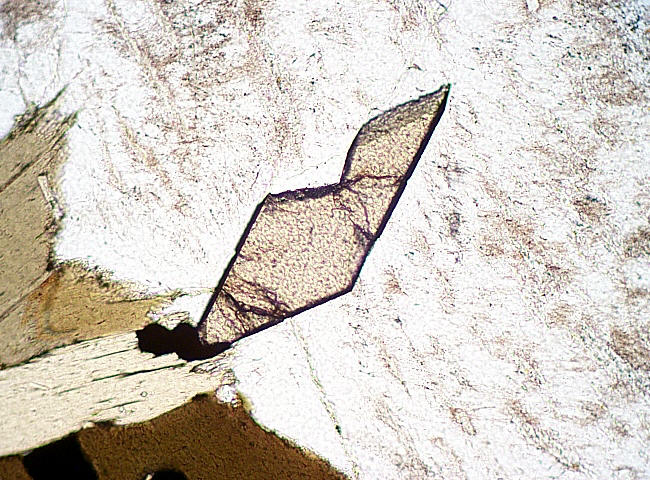 |
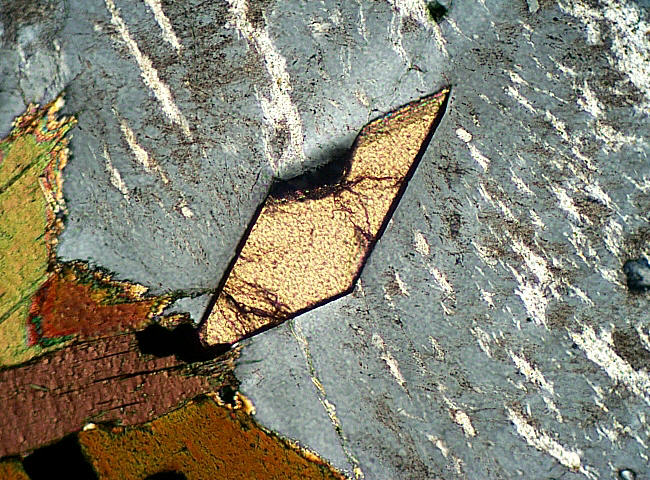 |
|
Titanite in a metaluminous granite. Titanite (formerly sphene) has a typical double-wedge or diamond shape, is typically light-brown, and has very high relief, higher than the pyroxenes or garnet. Titanite birefringence is very high, making it difficult to determine interference color order from the high-order pastel interference colors normally seen. Plane/cross-polarized light, field width is 1.2 mm. DIG-D |
酸化アルミ分の少ない花崗岩中のくさび石.くさび石(以前はスフェーンと呼ばれていた)は2つの楔形や菱形をしているが,典型的には淡い茶色で,輝石や柘榴石より高いレリーフを持つ.くさび石の複屈折は大変高く,ふつう高次のパステル色が見えるので,干渉色の順を決めるのは難しい. PPL/XPL,視野幅は1.2mm. |
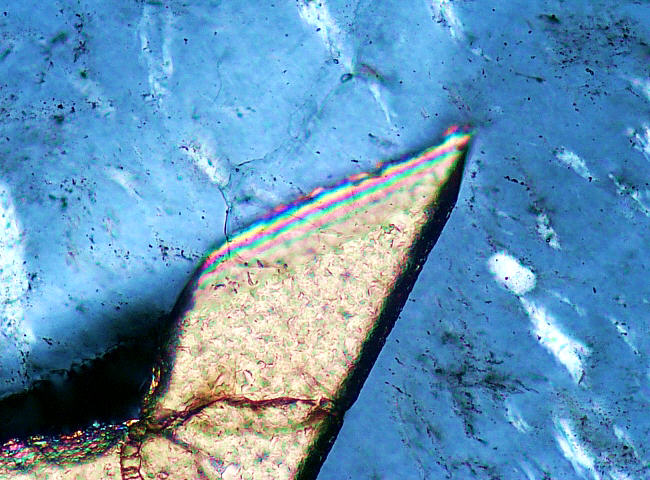 |
|
|
Titanite in a metaluminous granite. At high magnification, the magenta bands can be counted up a thin edge to get a better idea of the interference order. This example is approximately 6th order. Cross-polarized light, field width is 0.6 mm. DIG-D |
酸化アルミ分の少ない花崗岩中のくさび石.高倍率では,干渉色の順序によいアイデアを得るために,薄いエッジで赤いバンドがカウントできる.この例ではおおよそ6次である. XPL,視野幅は0.6mm. |
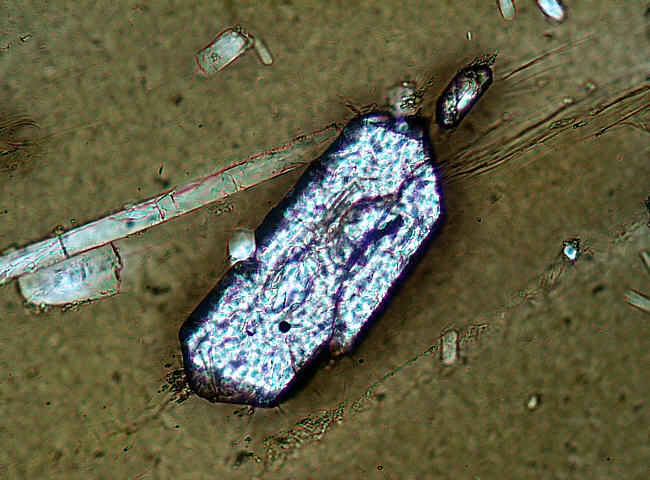 |
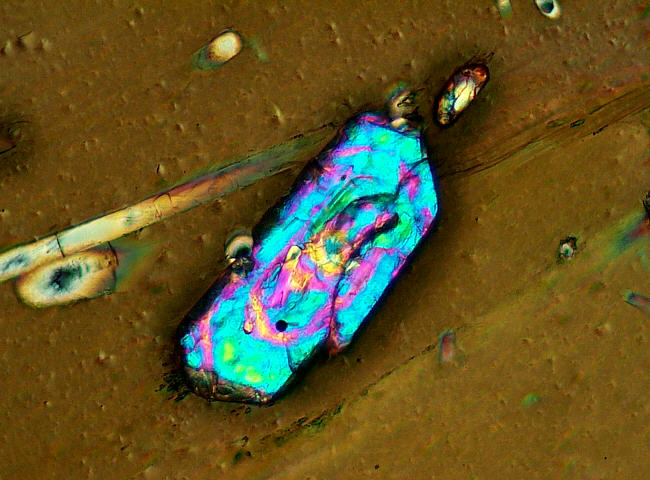 |
|
Zircon in a metaluminous granite. This is a rather blocky zircon fully enclosed within biotite. Small apatite crystals surround it. Zircon has relief considerably higher than garnet, pyroxenes, or titanite. The uranium and thorium content of zircon causes development of pleochroic radiation halos around it. Zircon birefringence is typically in the 3rd order. This example has birefringence zoning that is probably caused by igneous compositional zoning. High uranium layers accumulate more radiation damage and become less birefringent. Plane/cross-polarized light, field width is 0.6 mm. DIG-D |
酸化アルミ分の少ない花崗岩中のジルコン.
これは黒雲母の中にすべてが封入された,ややブロック状のジルコン.小さなアパタイトの結晶がそれを取り囲む.ジルコンは,柘榴石や輝石,あるいはくさび
石よりかなり高いレリーフを持つ.ジルコンのウランやトリウム成分が多色性を持つ放射ハローをその周囲に生じさせている.ジルコンの複屈折は,典型的には
3次のオーダー.このサンプルでは火成作用の成分ゾーニングでおそらく生じた複屈折のゾーニングを持つ.ウランに富む層では放射性のダメージを与え,そこ
では複屈折は低くなる. PPL/XPL,視野幅は0.6mm. |
|
Zircon compared to monazite . |
ジルコンとモナザイトの比較 |
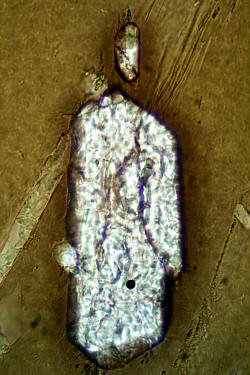 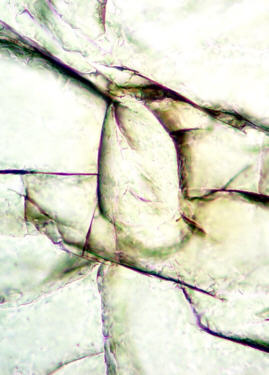
|
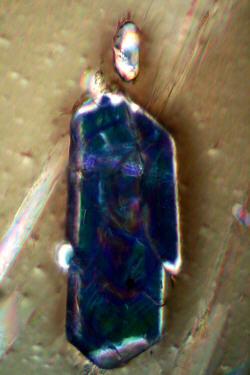 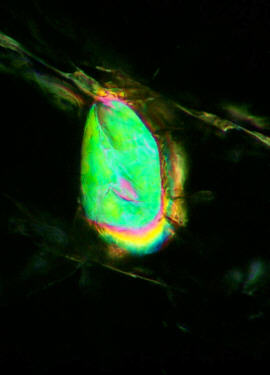 |
|
Left: Zircon oriented N-S. Zircon is usually colorless in thin section Plane-polarized light, field widths are 0.3 mm. |
Left: In the same orientation zircon is extinct, and so it has parallel extinction. right: In the same orientation Monazite is not extinct, and so it must have inclined extinction. Xenotime is tetragonal, like zircon, so it can't be distinguished so easily. Cross-polarized light, field widths are 0.3 mm. |
|
左:NS方向に向いたジルコン.ジルコンは薄片では通常無色である. 右:NS方向を向いたモナザイト.モナザイトは薄片ではとても淡い黄緑色である.この粒は隣り合う柘榴石に淡茶色の放射ハローを発達させる.PPL 視野幅は0.3mm. | 左:同じ方向のジルコンが消光している.つまりこれは直消光を示す. 右:同じ方向のモナザイトは消光しない.つまりこれは斜消光にちがいない. ゼノタイムはジルコンと同じように正方晶系で,区別は簡単ではない. |
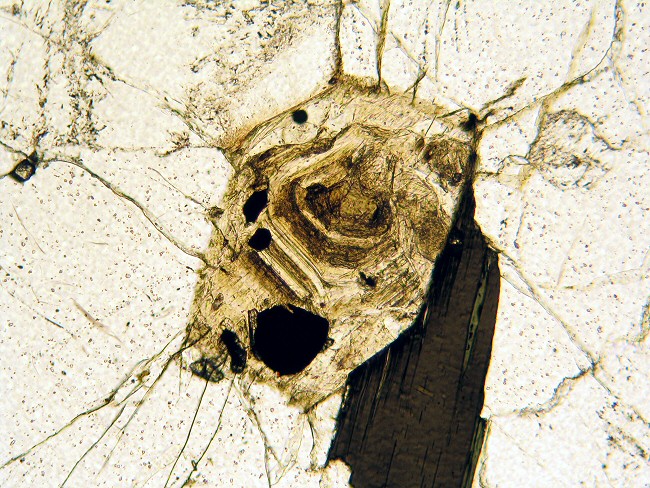 |
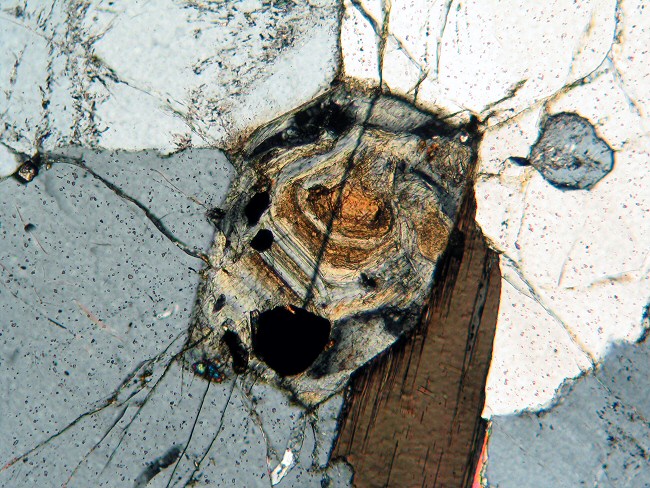 |
|
Allanite in a metaluminous granite. This allanite has concentric zoning, probably from changing mineral composition during successive stages of growth. Allanite contains substantial amounts of Th and U, and sustains considerable radiation damage over time. Swelling of the crystal as damage accumulates, and absorption of water, causes radial cracks that extend out into the surrounding minerals. This allanite grain mostly has low birefringence, a result of radiation damage that has essentially turned the crystal lattice into a glass. Plane/cross-polarized light, field width is 1.2 mm. 4.7.84G |
酸化アルミナが少ない花崗岩中の褐簾石.
この褐簾石は成長過程で鉱物組成が変化したための同心円状のゾーニングを持つ.褐簾石は相当な量のUとThを含んでいるので,長期にわたりかなりな量の放
射線のダメージを与え続ける.ダメージが積み重なるための結晶の膨張と,水の吸収のため,その周囲の鉱物に放射状の亀裂を生じさせる.この褐簾石の粒はほ
とんど低い複屈折で,放射線のダメージのために,本質的に結晶格子がガラスに変化してしまっている. PPL/XPL,視野幅は1.2mm. |
Secondary minerals |
2次鉱物 |
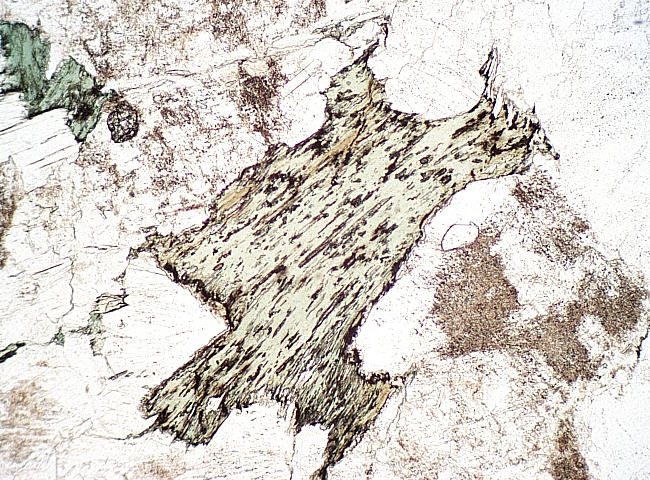 |
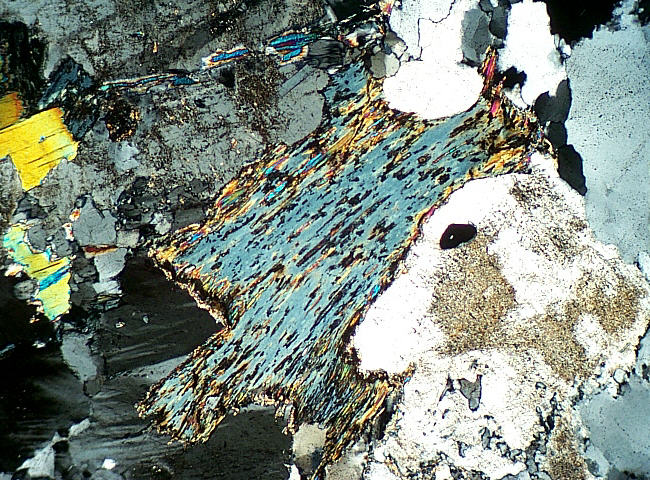 |
|
Chlorite replacing biotite in a muscovite granite. Small residual brownish patches of biotite still occur, as do dark bits of titanite. Biotite can hold several weight percent TiO2 in solid solution, but secondary chlorite can accommodate ≪1%. The low first order, anomalous Berlin blue interference color indicates that this is an Fe-rich chlorite. Residual biotite patches have higher birefringence. Plane/cross-polarized light, field width is 3 mm. NEIGC84-A5-6 |
白雲母花崗岩中の黒雲母を置換した緑泥石.まだ茶色い黒雲母のパッチが残っている.さらにくさび石の暗い小さなビットもある.黒雲母は固溶体中にある量のTiO2を含むことができるが,2次生成の緑泥石は1%以下のわずかな量しか含めないため.低い1次の異常な青い干渉色が示すようにこれは,鉄に富んだ緑泥石である.残留した黒雲母はもっと高い複屈折を示している. PPL/XPL,視野幅は3mm. |
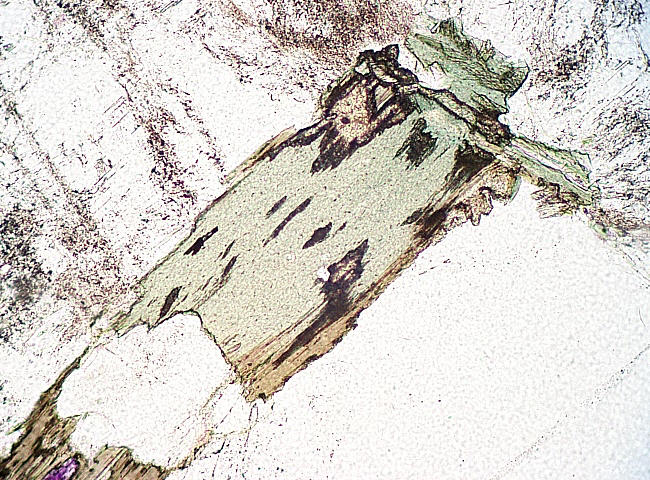 |
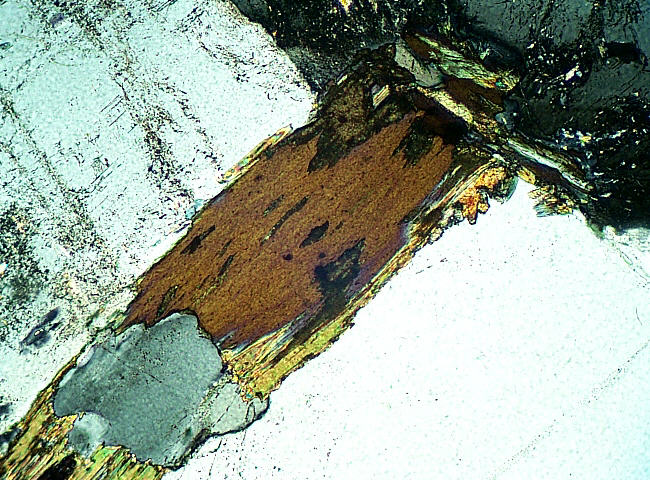 |
|
Chlorite replacing biotite in a metaluminous granite. Lenses of high-index colorless material (titanite?) occur in the chlorite, and a small amount of brown biotite survives in the lower part of the grain. The chlorite mostly has an anomalous brown low first order interference color, indicative of Mg-rich chlorite. The regions with purple birefringence are more Fe-rich. The adjacent biotite has third order birefringence. Plane/cross-polarized light, field width is 1.2 mm. DIG-D |
酸化アルミナに乏しい花崗岩中の黒雲母を置換した緑泥石.
高い屈折率の無色の物質(くさび石?)が緑泥石の中に生じている.また粒の下方には少ない量の茶色い黒雲母が生き残っている.緑泥石が異常に茶色い低次の
1次干渉色を見せているのはMgに富むことを示す.複屈折が紫の領域は,もっと鉄に富む部分.隣接する黒雲母は3次の複屈折を持つ. PPL/XPL,視野幅は1.2mm. |
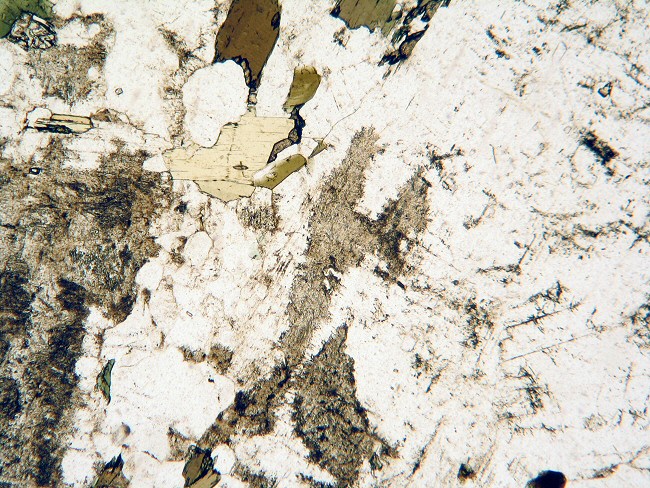 |
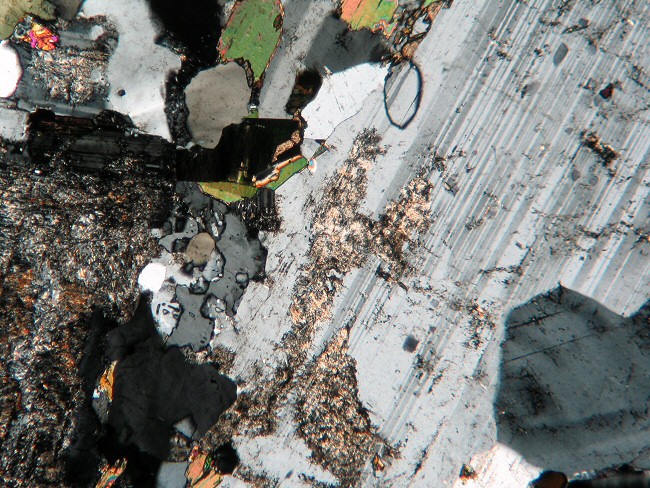 |
|
Sericite replacing plagioclase in a metaluminous granite. Sericite is grungy-looking fine-grained stuff that commonly replaces feldspars. Close examination of sericite reveals that at least some of it is fine-grained white mica. Because it is generally made up of very small crystals, its birefringence is irregular and generally low. Some of the larger crystals can be seen here to have first order birefringence. Albite twinning in the plagioclase is clearly visible. Plane/cross-polarized light, field width is 3 mm. UN30A |
酸化アルミナに乏しい花崗岩中の斜長石を置換した絹雲母(セリサイト).
絹雲母は普通,長石を置換するごつごつした細粒の物質である.よく絹雲母を見てみると,それらの一部は細粒の白い雲母であることがわかる.それらは通常,
非常に細かい結晶であるため,その複屈折は不規則で一般的に低い.ここでみられる幾つかの大きめの結晶は1次の複屈折を持つ.斜長石のアルバイト双晶が明
瞭に見えている. PPL/XPL,視野幅は3mm. |
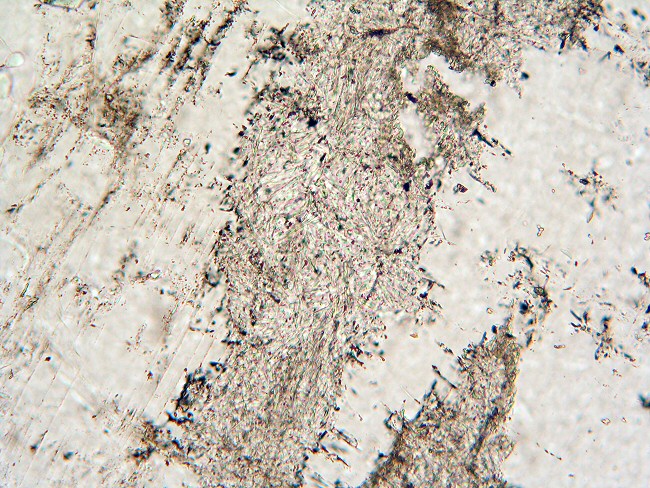 |
 |
|
Sericite replacing plagioclase in a metaluminous granite. At higher magnification, some of the grungy-looking material resolves into little, colorless, platy crystals. The larger crystals have up to middle first order birefringence. They have a positive sign of elongation and are probably small white micas that grew during subsolidus hydrothermal alteration. Plane/cross-polarized light, field width is 1.2 mm. UN30A |
酸化アルミナに乏しい花崗岩中の斜長石を置換した絹雲母(セリサイト).高い倍率下では,ごつごつした物質は細かい無色の板状の結晶に分かれる.大きな結晶は中間の1次の複屈折に達する.それらは正の伸長性を持ち,おそらく固相での熱水交代作用のときに成長した白い雲母だと思われる. PPL/XPL,視野幅は1.2mm. |
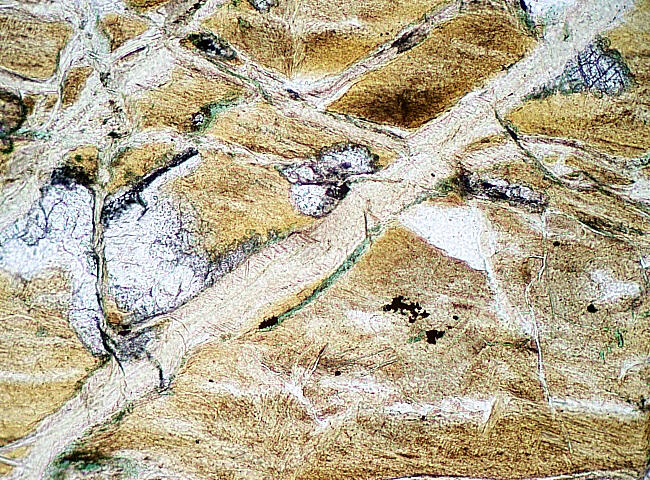 |
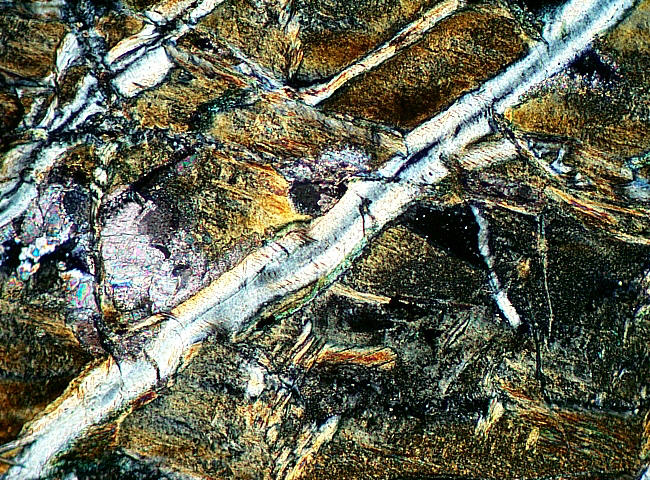 |
|
Serpentine in an altered harzbergite nodule in a kimberlite dike from Pennsylvania. Much of this sample is made of calcite (colorless) and stained talc (darker browns). The serpentine is the yellowish material in the thin veins. Calcite has very high birefringence, and the talc has irregular second and third order interference colors that are modified by the brown staining. The serpentine is most easily seen in the veins, where the fibers are perpendicular to the vein walls. Plane/cross-polarized light, field width is 3 mm. Fayette Co. Penn. 33 |
ペンシルバニアのキンバーライト岩脈の中の変質したハルツバージャイトノジュール中の蛇紋石.
このサンプルの大部分はカルサイト(無色)とふつうの滑石(暗い茶色)からなる.蛇紋石は薄い脈の黄色を帯びた物質である.カルサイト(方解石)はとても
高い複屈折をもち,滑石は不規則な2次ないし3次のオーダーの干渉色を持つが,それは茶色い色に染まって変容している.蛇紋石は脈の中に容易に見られ,そ
こでは繊維が脈の壁に直角に存在する. PPL/XPL,視野幅は3mm. |
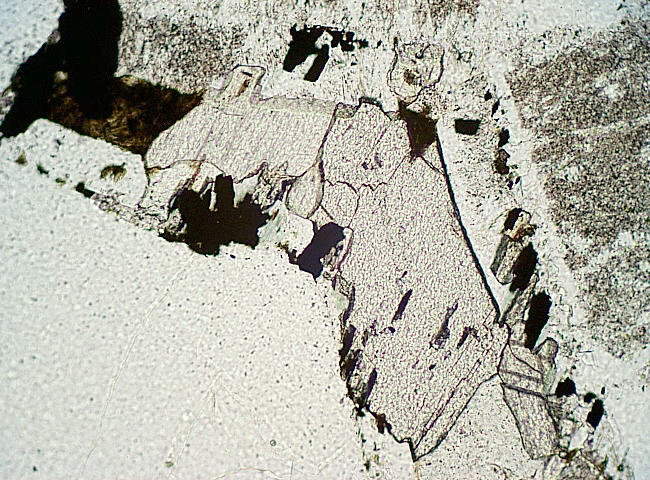
|
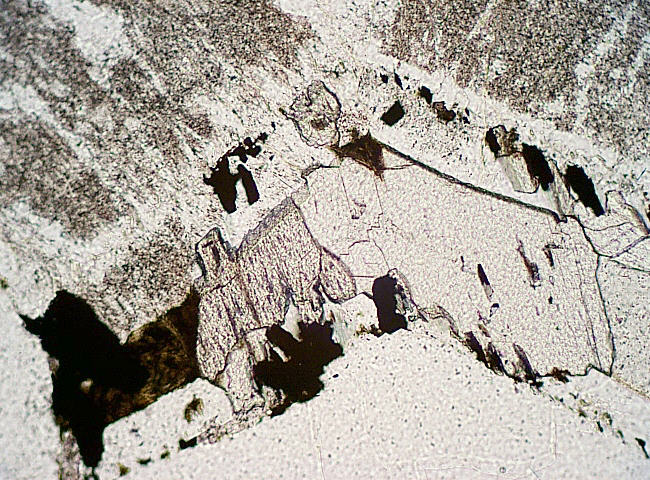 |
|
Calcite in an alkaline granite. This shows two images with the same patch of calcite in two different orientations. In the first view, the calcite grain to the upper left is oriented so that a N-S line bisects the obtuse angle between the cleavages. This means the c axis of the calcite is approximately N-S, so the N-S polarized light is parallel to the low calcite refractive index and the grain has rather low relief. In the second image, the calcite grain first has been rotated so that a N-S line bisects the acute angle between the cleavages, so the c axis is approximately E-W the high calcite refractive index is seen and so it has high relief. Calcite and dolomite are the only two common minerals that can noticeibly change from low to high relief on rotation in thin section. Both plane-polarized light, field width is 1.2 mm. NEIGC86-B2-7 |
アルカリ花崗岩のカルサイト(方解石).
これらの2つの画像は,異なる方向から見た同じ方解石のパッチである.最初の画像では,左上の方解石の粒は,NS方向線がへき開の鈍角を2等分する方向に
なっている.これは方解石のC軸がほぼNSであり,NS方向の偏光が低い方の方解石の屈折率と平行になる.したがって粒のレリーフはむしろ小さい.2つ目
の画像では,方解石の粒は回転され,へき開部の鋭角をNS線で2分するように置かれているので,C軸はほぼEWになる.その結果高い屈折率の位置で見え,レリーフが高い.方解石とドロマイトは一般的な鉱物の中で,薄片の回転により,レリ−フが低くめから高めに変化する,ただ2つの鉱物である. PPL/XPL,視野幅は1.2mm. |
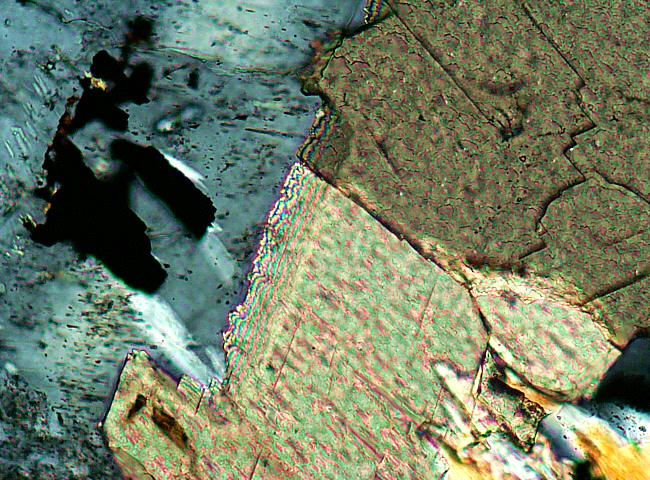 |
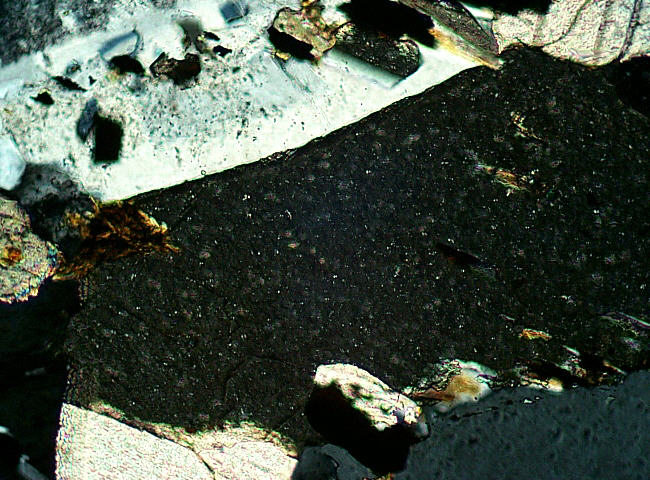 |
|
Calcite in an alkaline granite. Calcite has very high birefringence, so interference order is difficult to judge from the high-order pastel colors. It is more reliable to look at a thin edge and count the number of magenta bands. The thin edge to the left of center of the first image has ~8th order birefringence. The second image shows this same pair of grains, with one rotated to extinction. Calcite is quite soft and undergoes substantial surface deformation during normal thin section grinding. The distorted crystal surface, combined with its high birefringence, results in incomplete, speckled extinction. Both cross-polarized light, field width is 0.6 mm. NEIGC86-B2-7 |
アルカリ花崗岩のカルサイト(方解石).
方解石の複屈折はとても高い.したがって,干渉色の順は高いレベルのパステル色からジャッジするのが困難となる.そこで結晶の端で,マゼンタバンドが何回
あるかをカウントするのが1番確からしい方法である.中央左のエッジでは,複屈折が1次から8次まで数えられる.2番めの画像は同じ粒を回転させて消光に
持ってきたもの.方解石は通常の薄片製作過程で,とても柔かく表面近くで変形する.高い複屈折と歪んだ表面のため,消光は不完全でまだら模様となる. PPL/XPL,視野幅は0.6mm. |
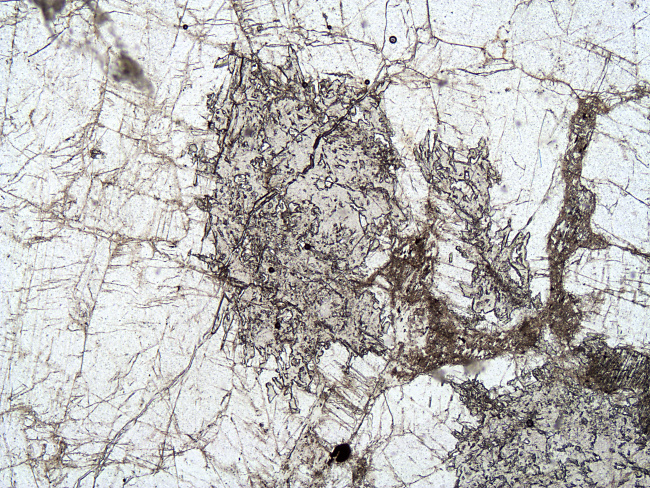 |
 |
|
Zoisite developed in plagioclase in an anorthosite. Zoisite is essentially an orthorhombic, very low-Fe epidote. As an alteration product it commonly forms as masses or veins of irregular, ragged crystals in Ca-rich plagioclase. Zoisite has low first-order birefringence that is characteristically anamalous Berlin-blue and anomalous brown, caused by very high dispersion of the 2V. Plane/cross-polarized light, field width is 3.0 mm. STWR-8 |
アノーソサイト(斜長岩)中の斜長石に発達したゆうれん石(ゾイサイト).ゾイサイトは本質的に斜方晶系である.変質鉱物なので通常それはCaに富む斜長石の中で,荒れた不規則な脈やかたまりになる.ゾイサイトは低次の1次複屈折を持つが,特徴的な異常干渉色を示す.ベルリン青と異常な茶色が2Vのとても高い分散から生じる. PPL/XPL,視野幅は3mm. |